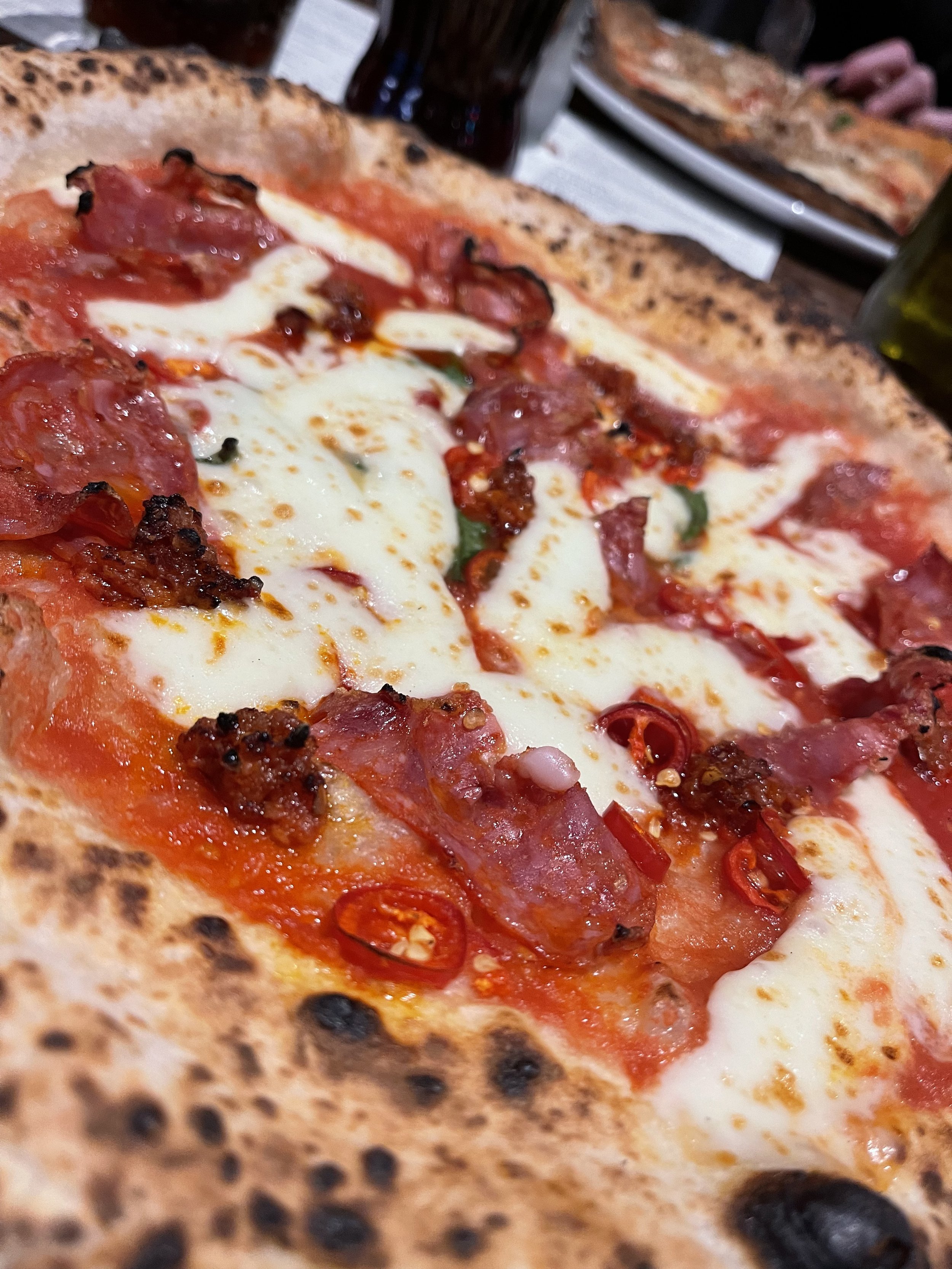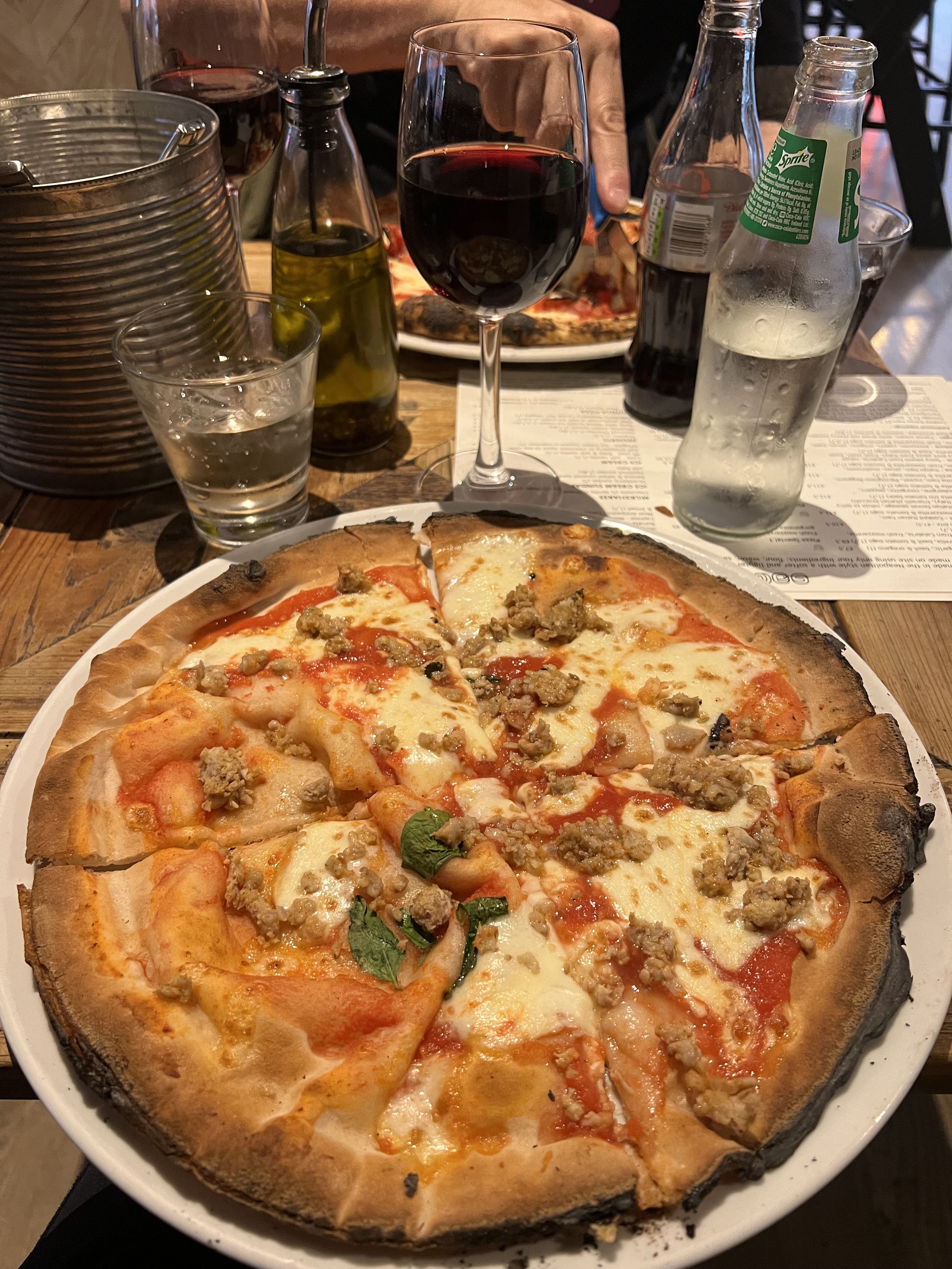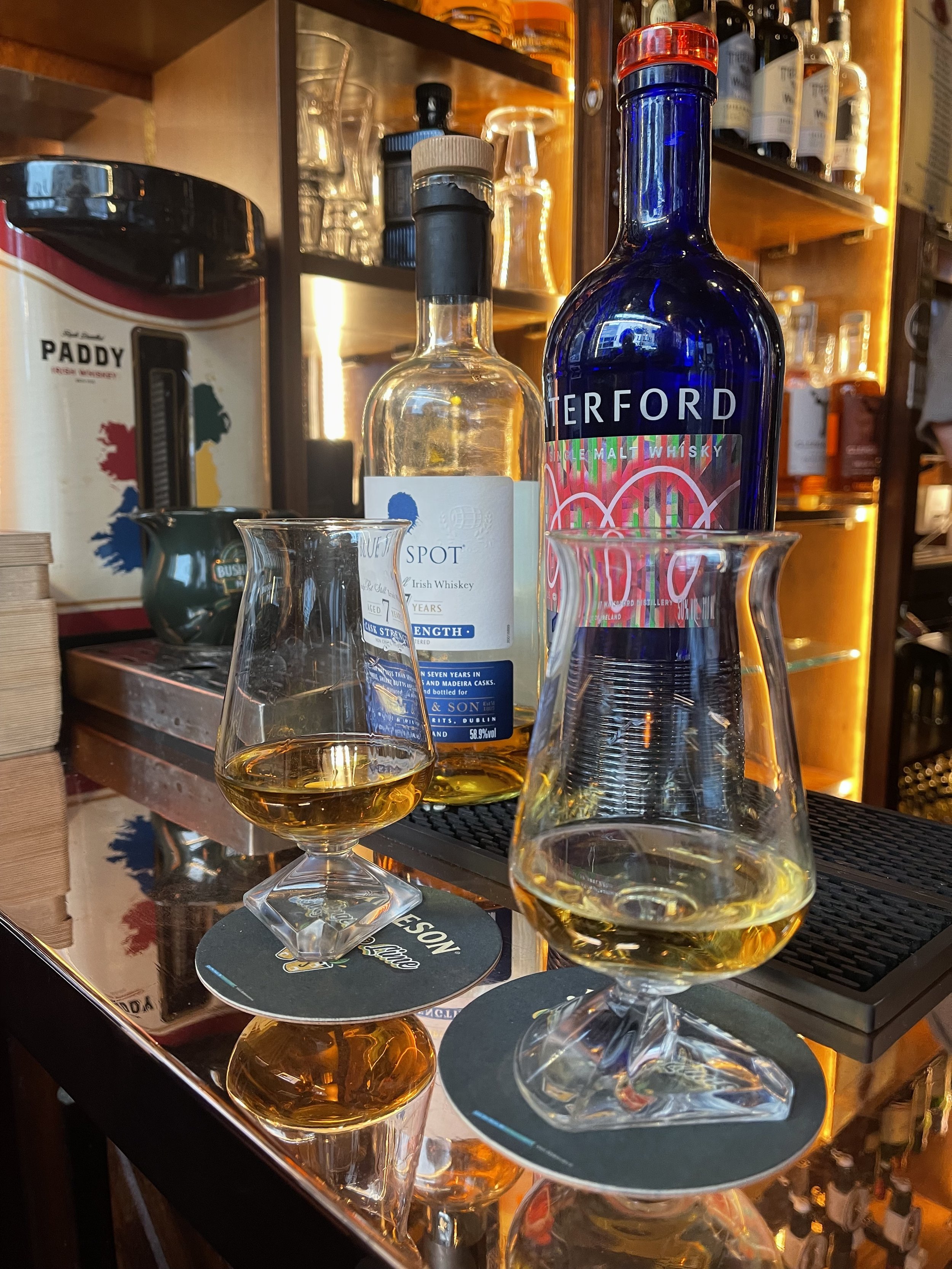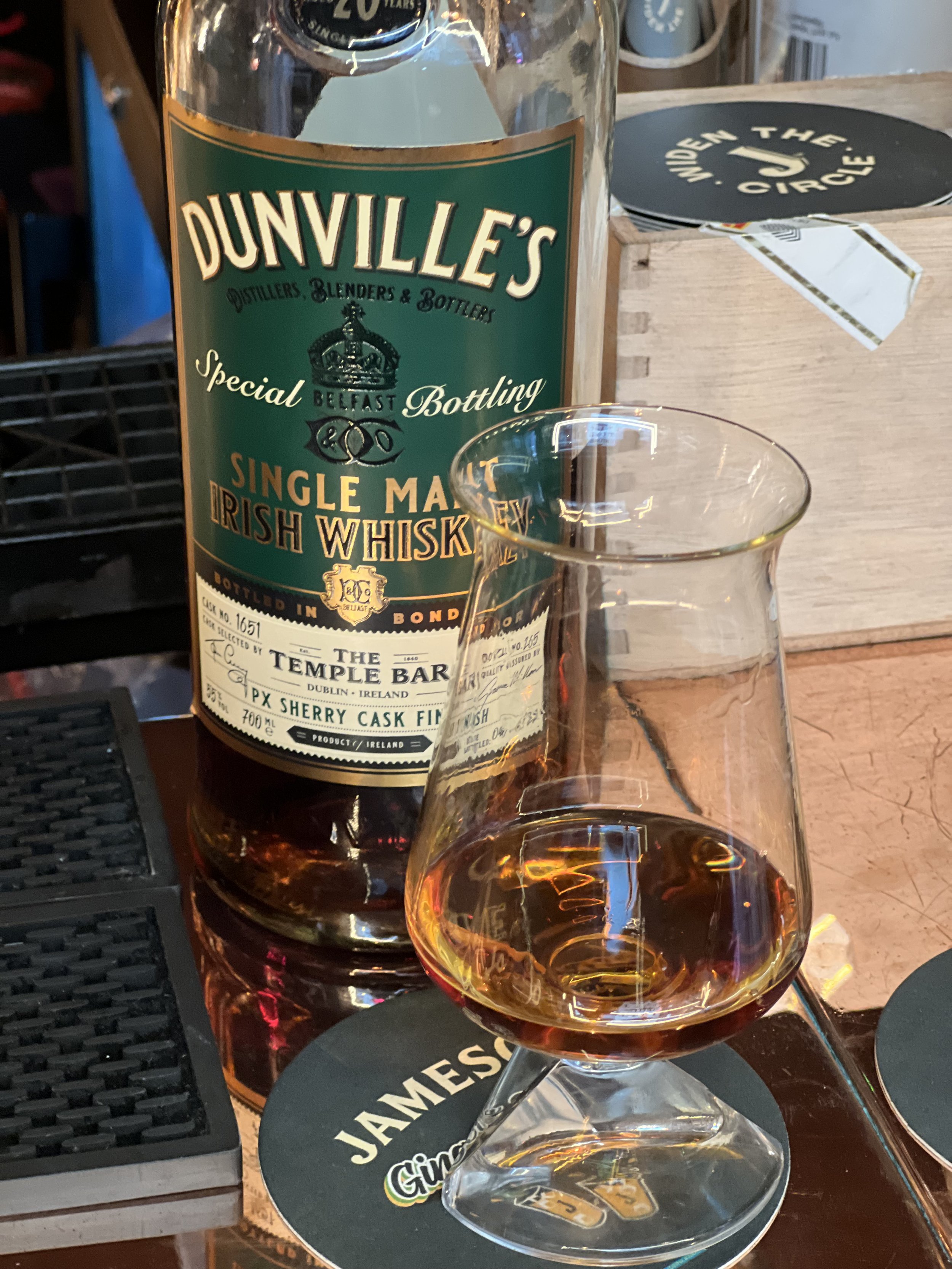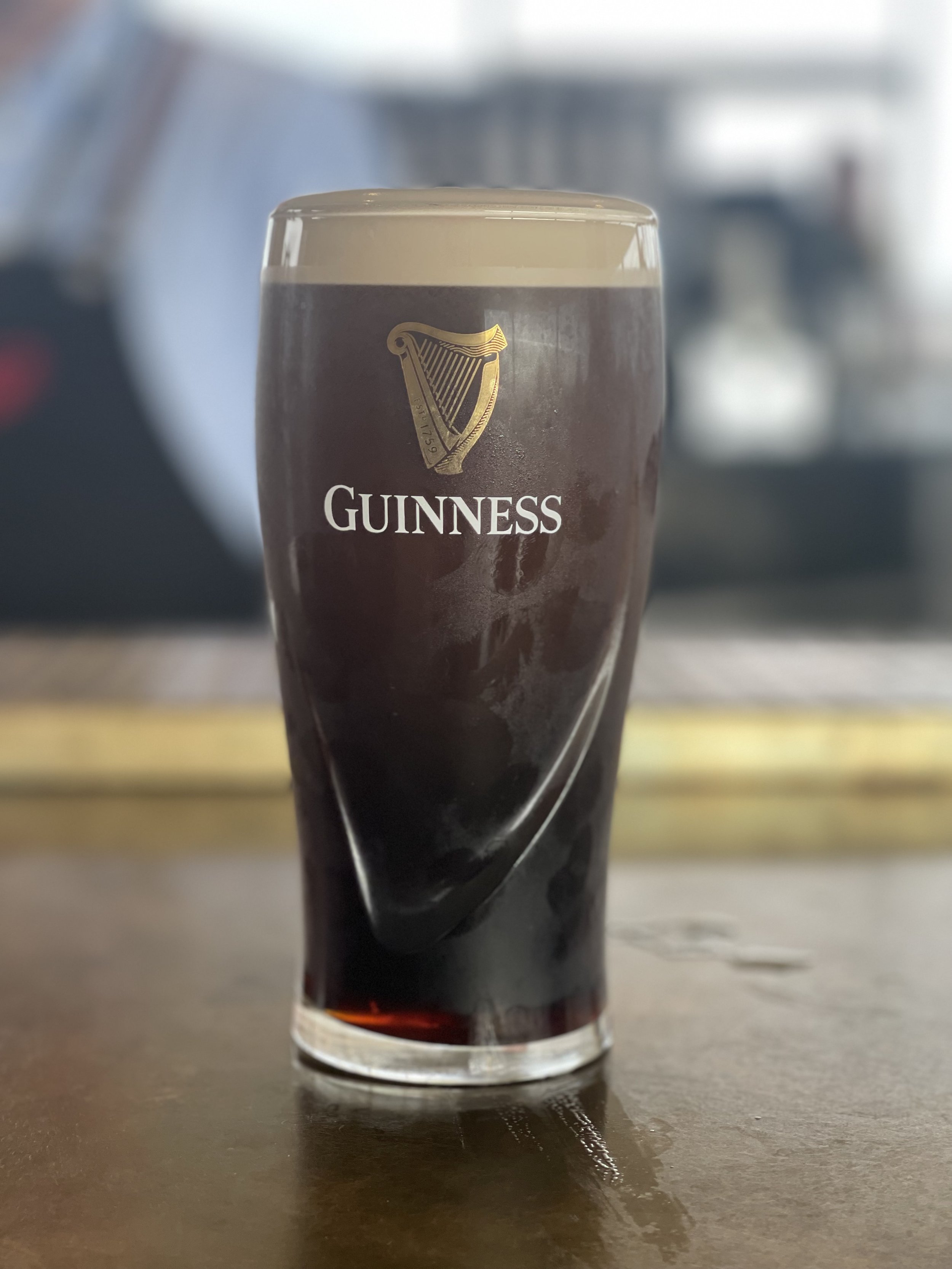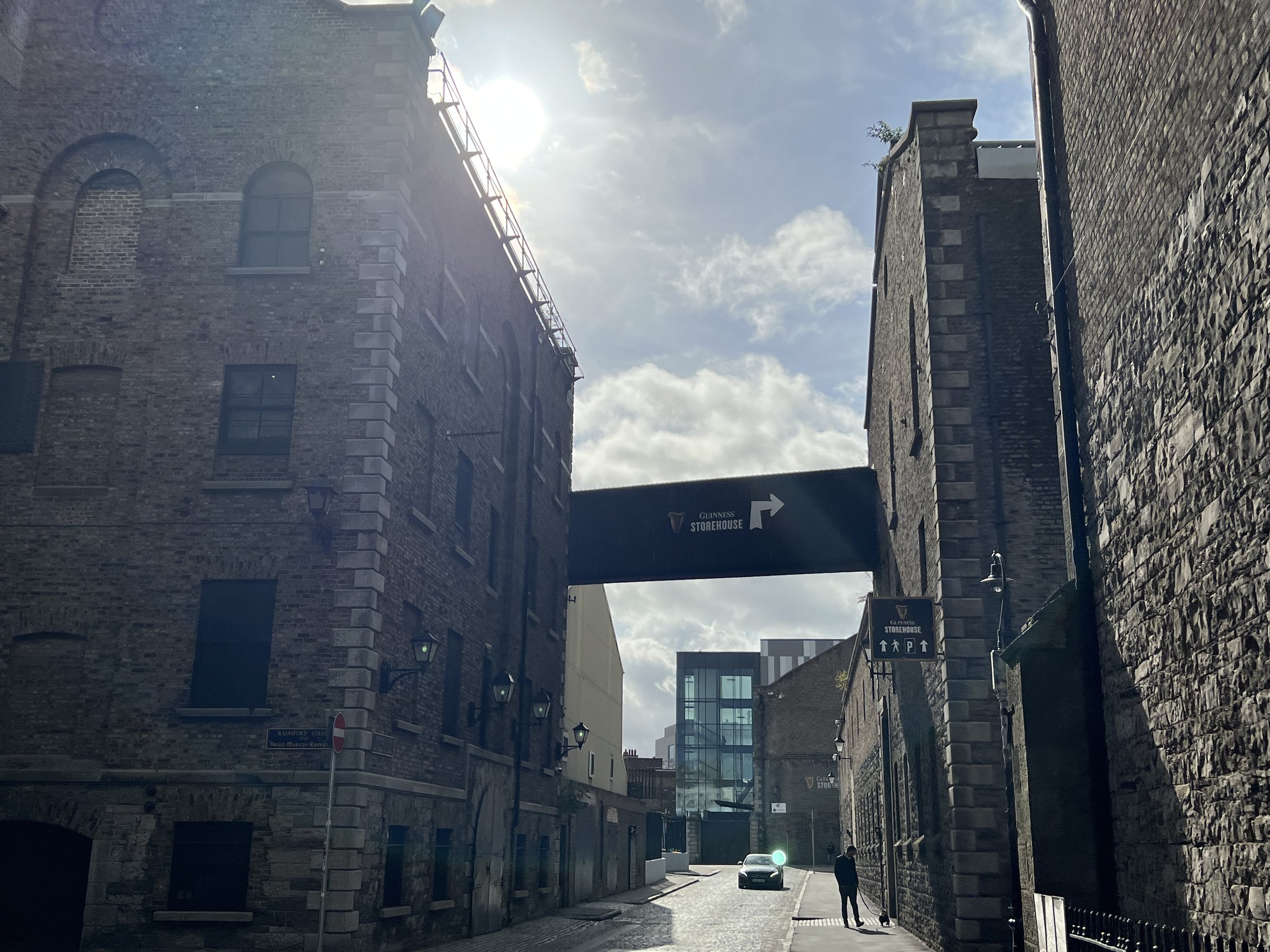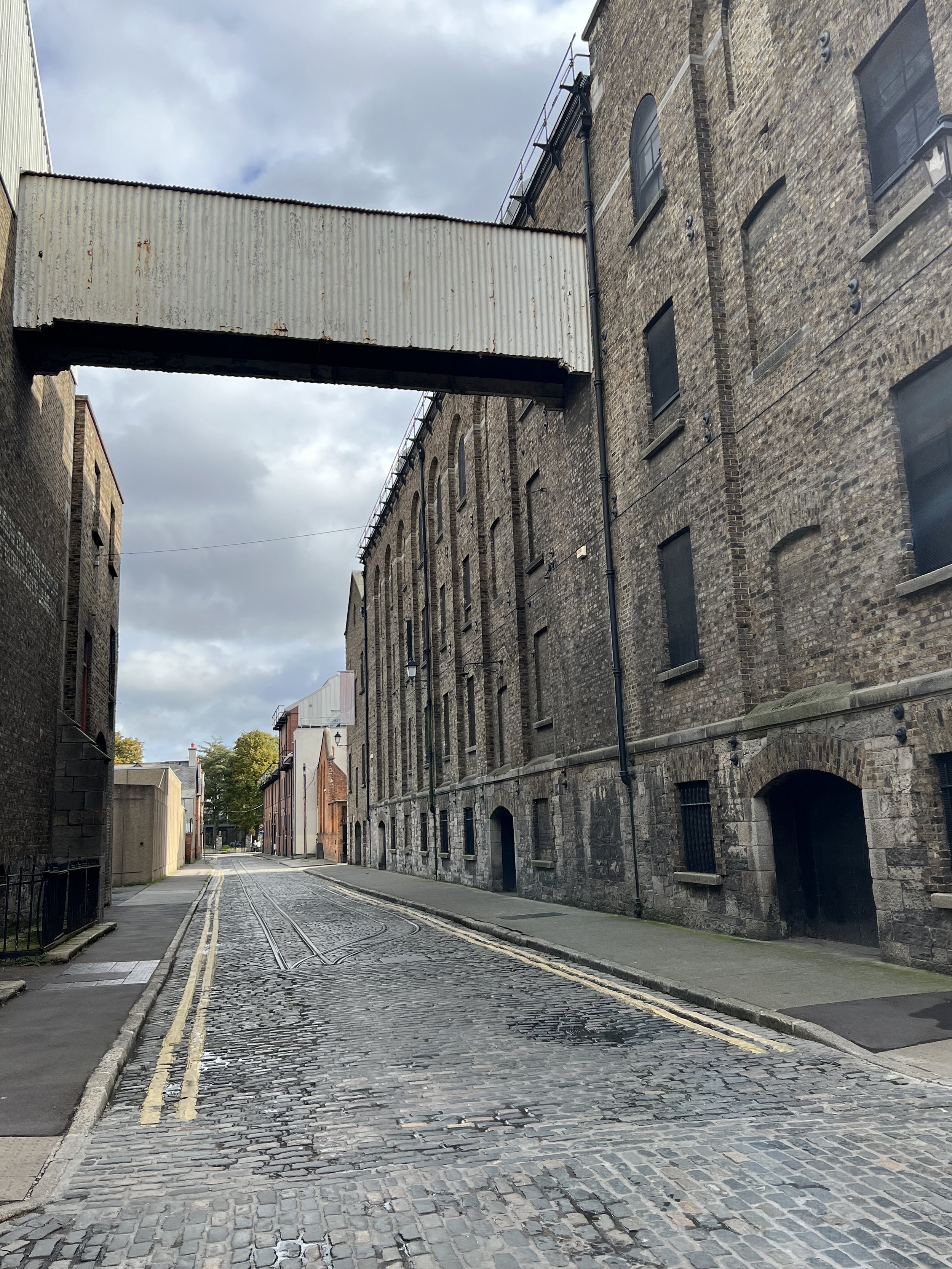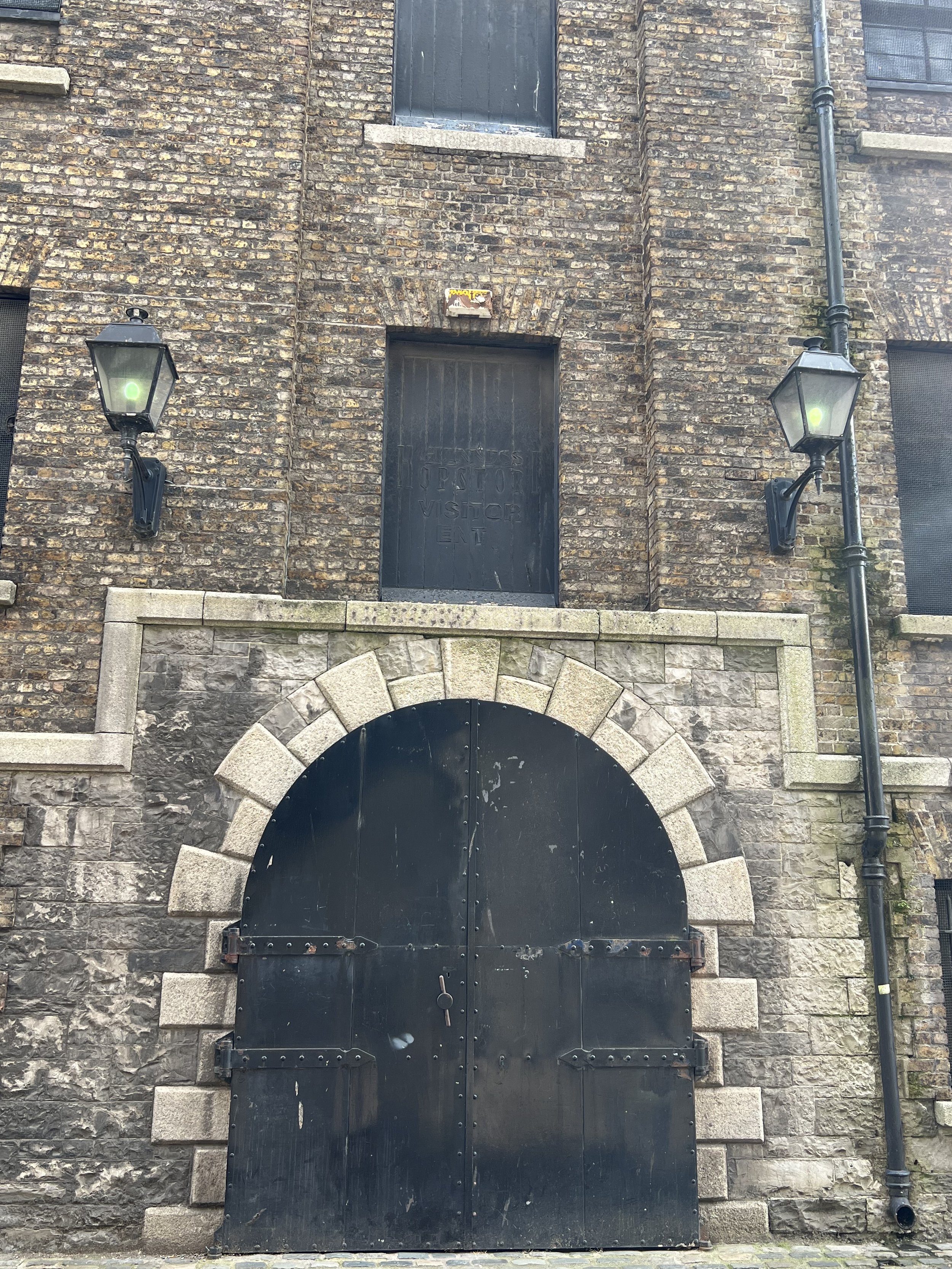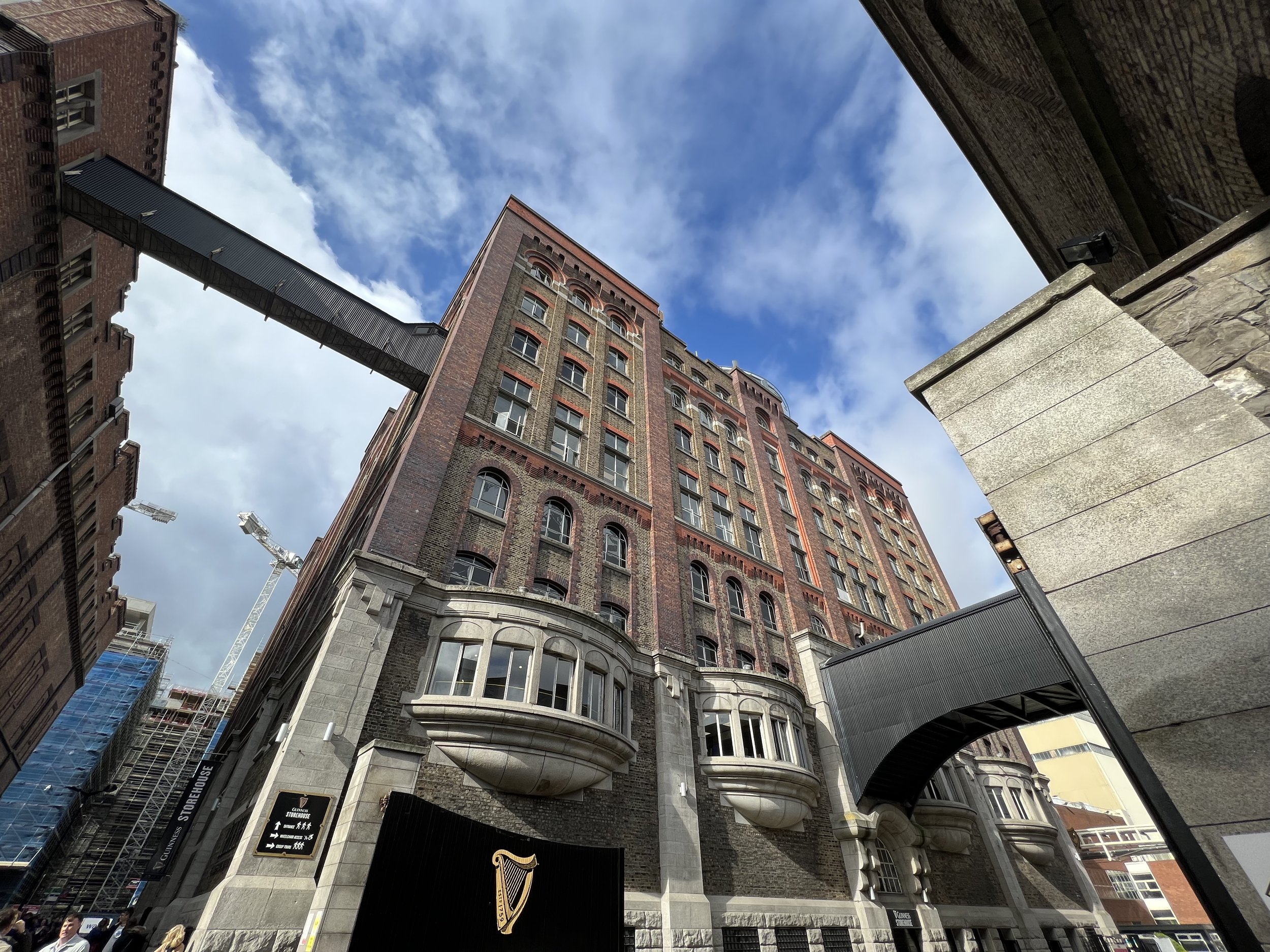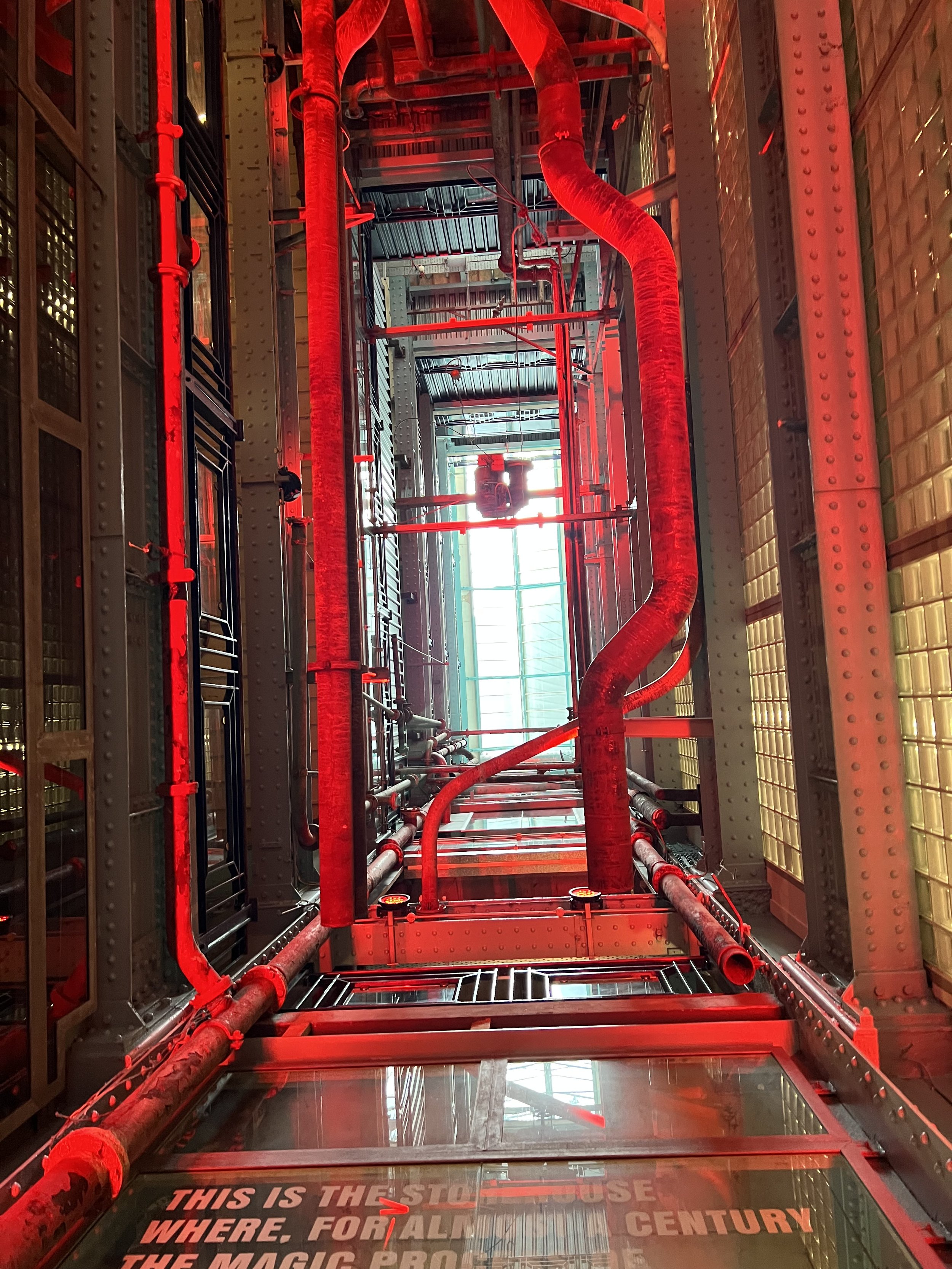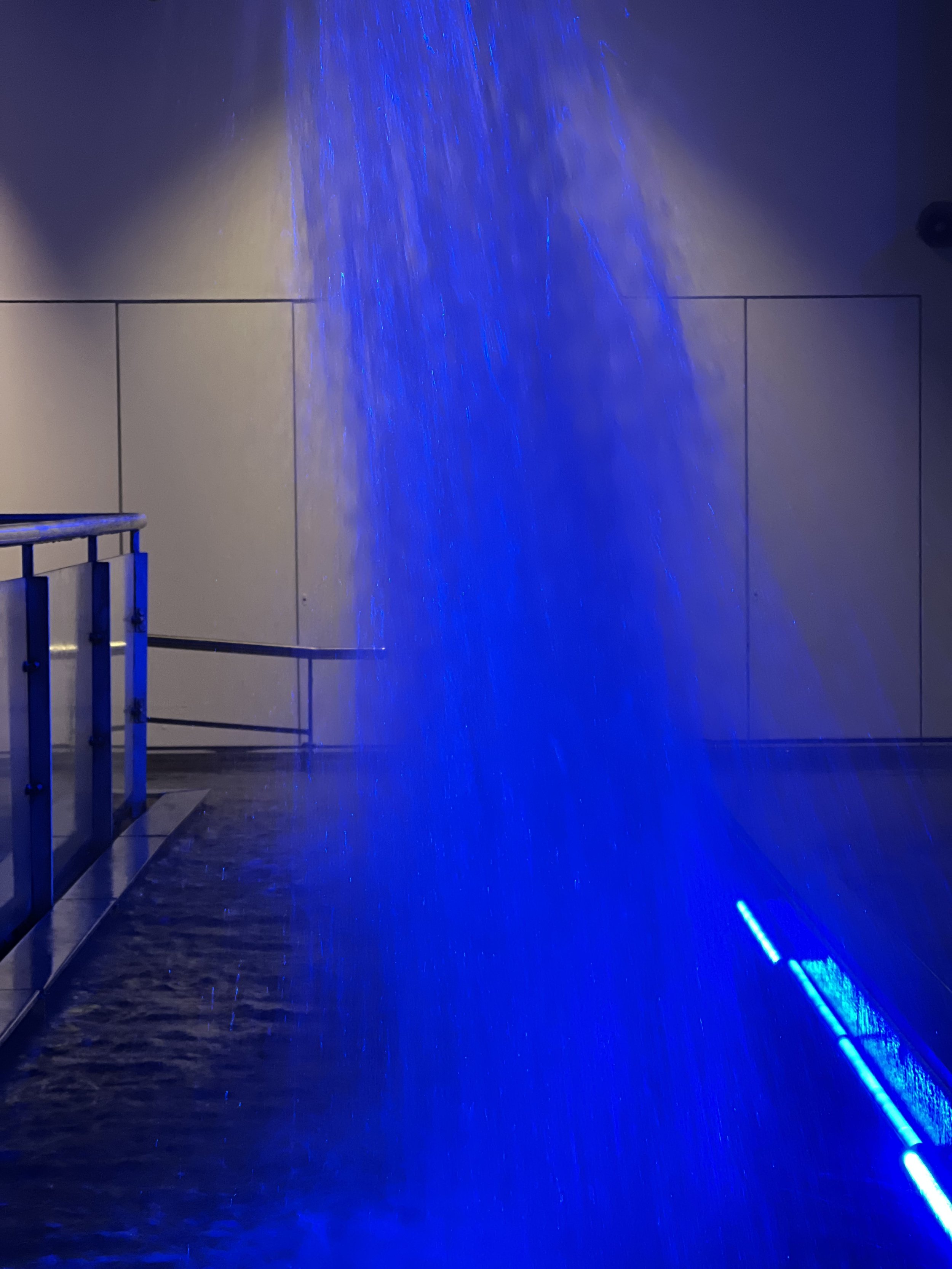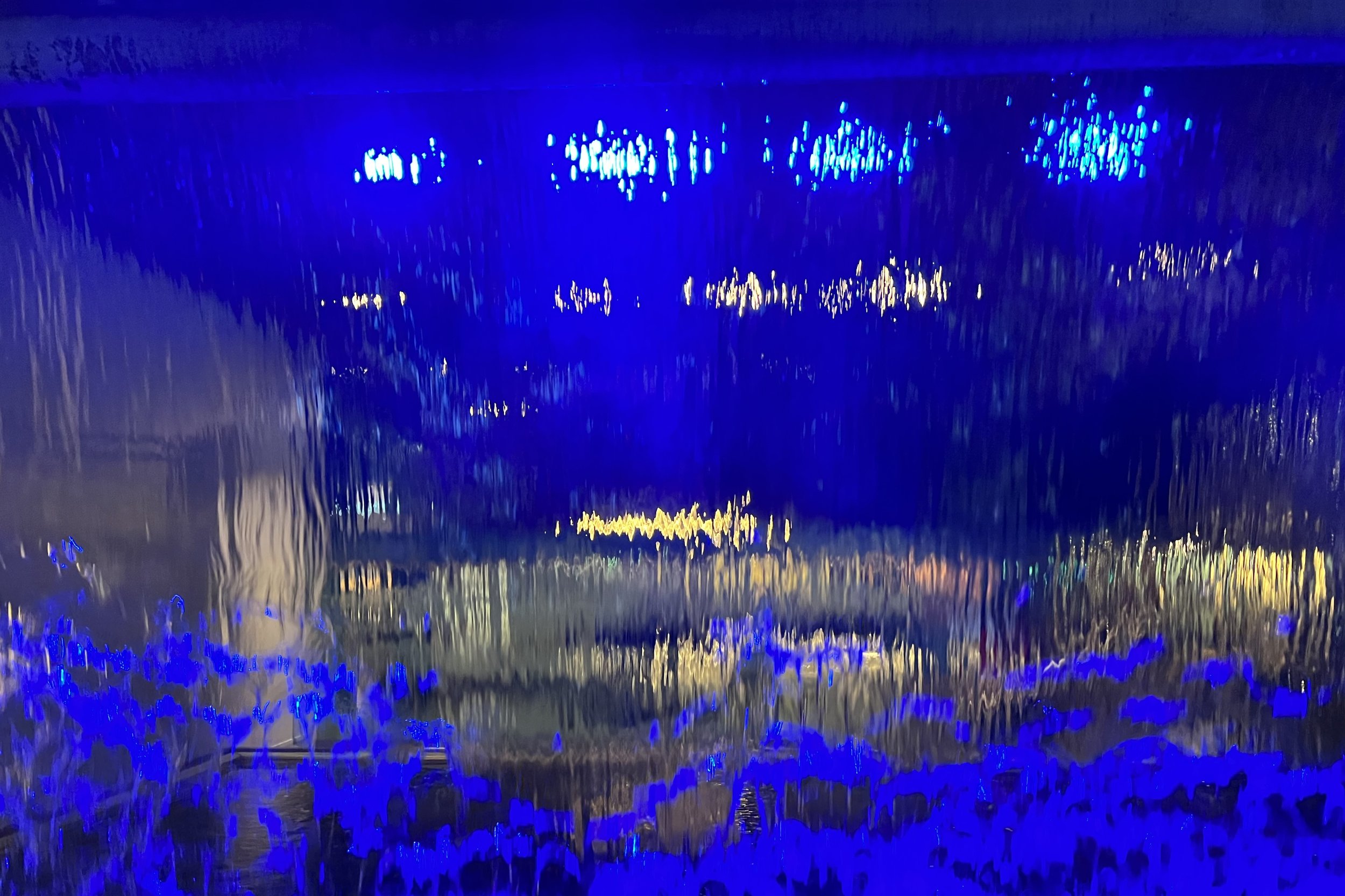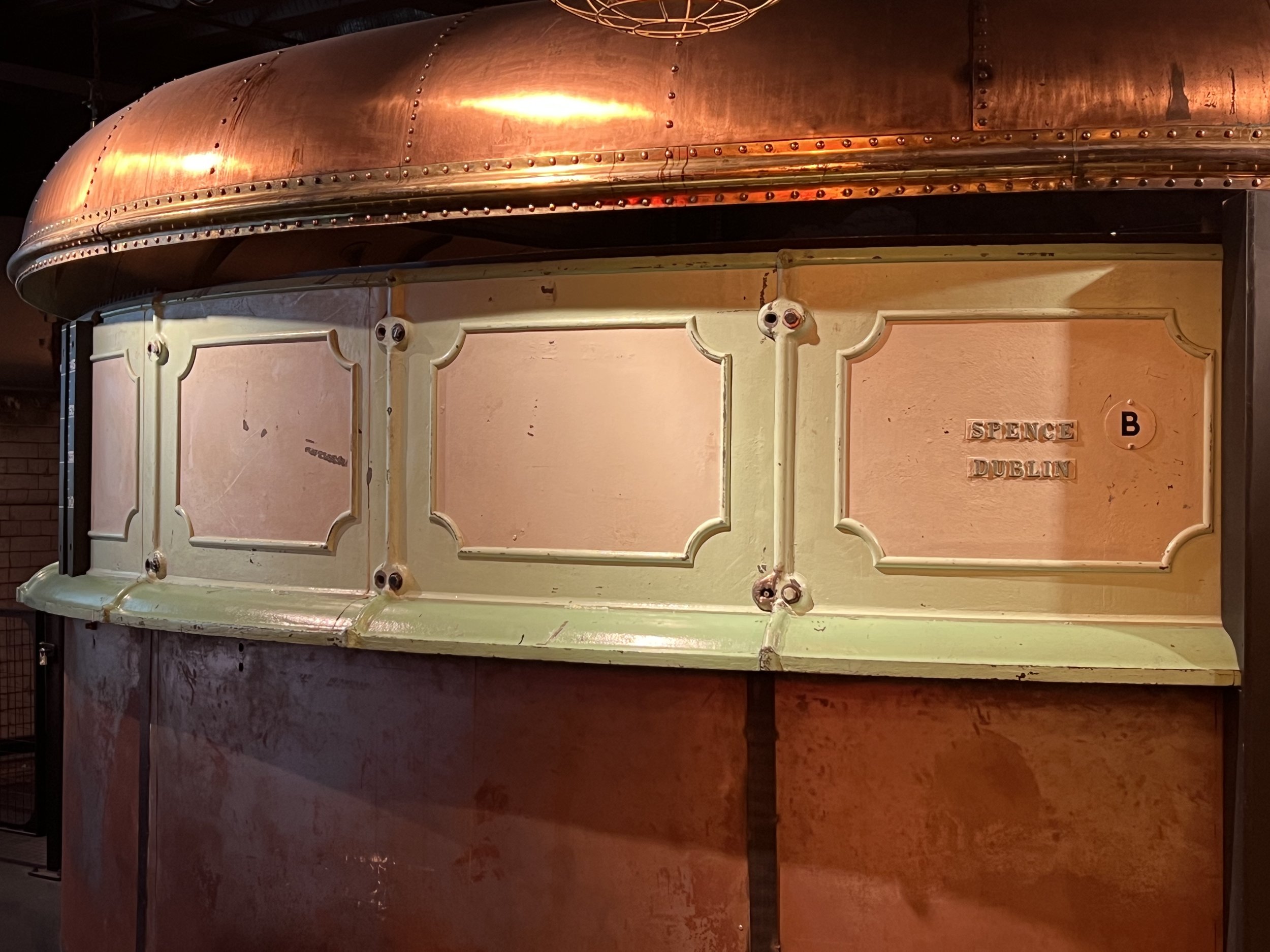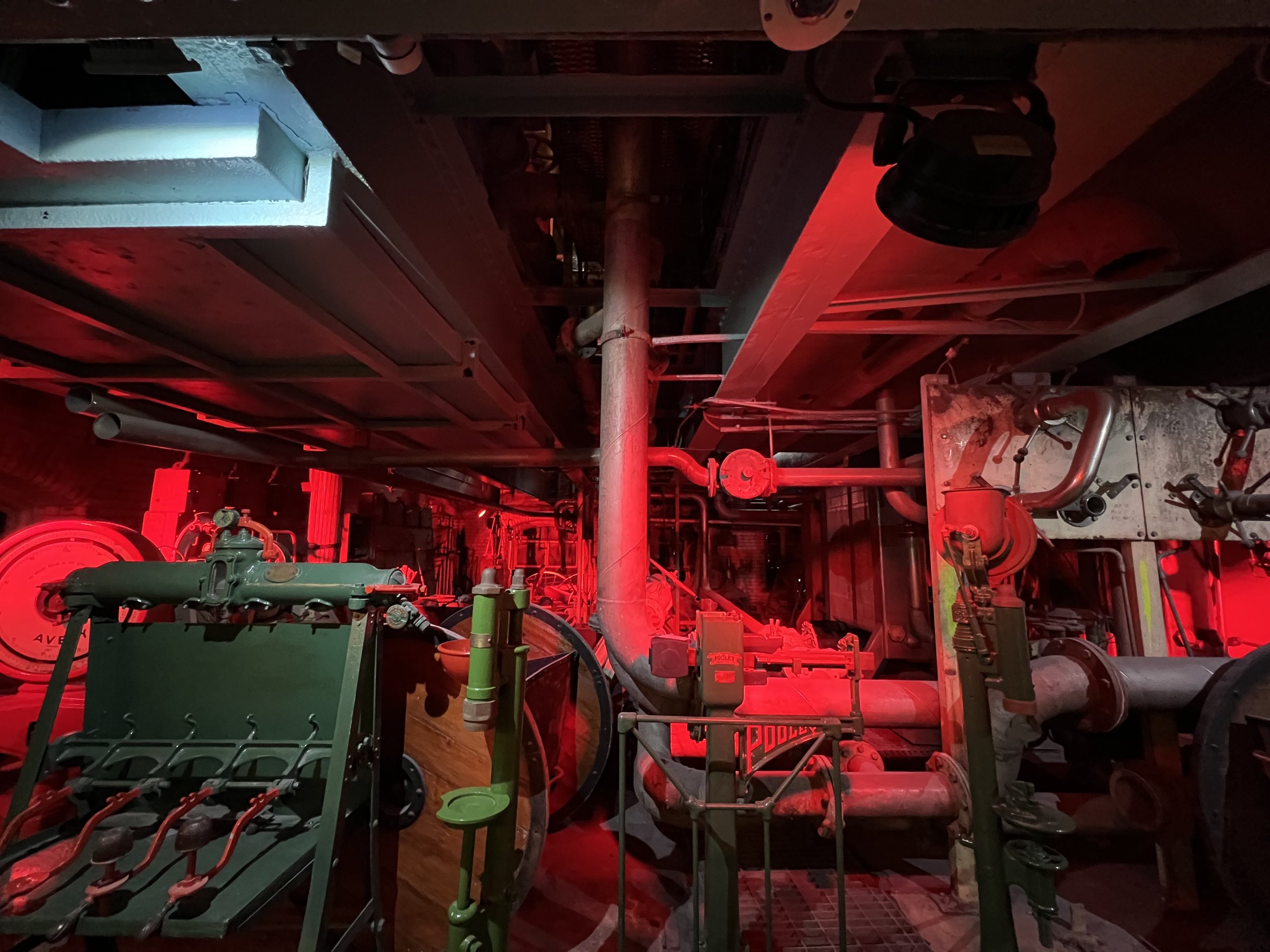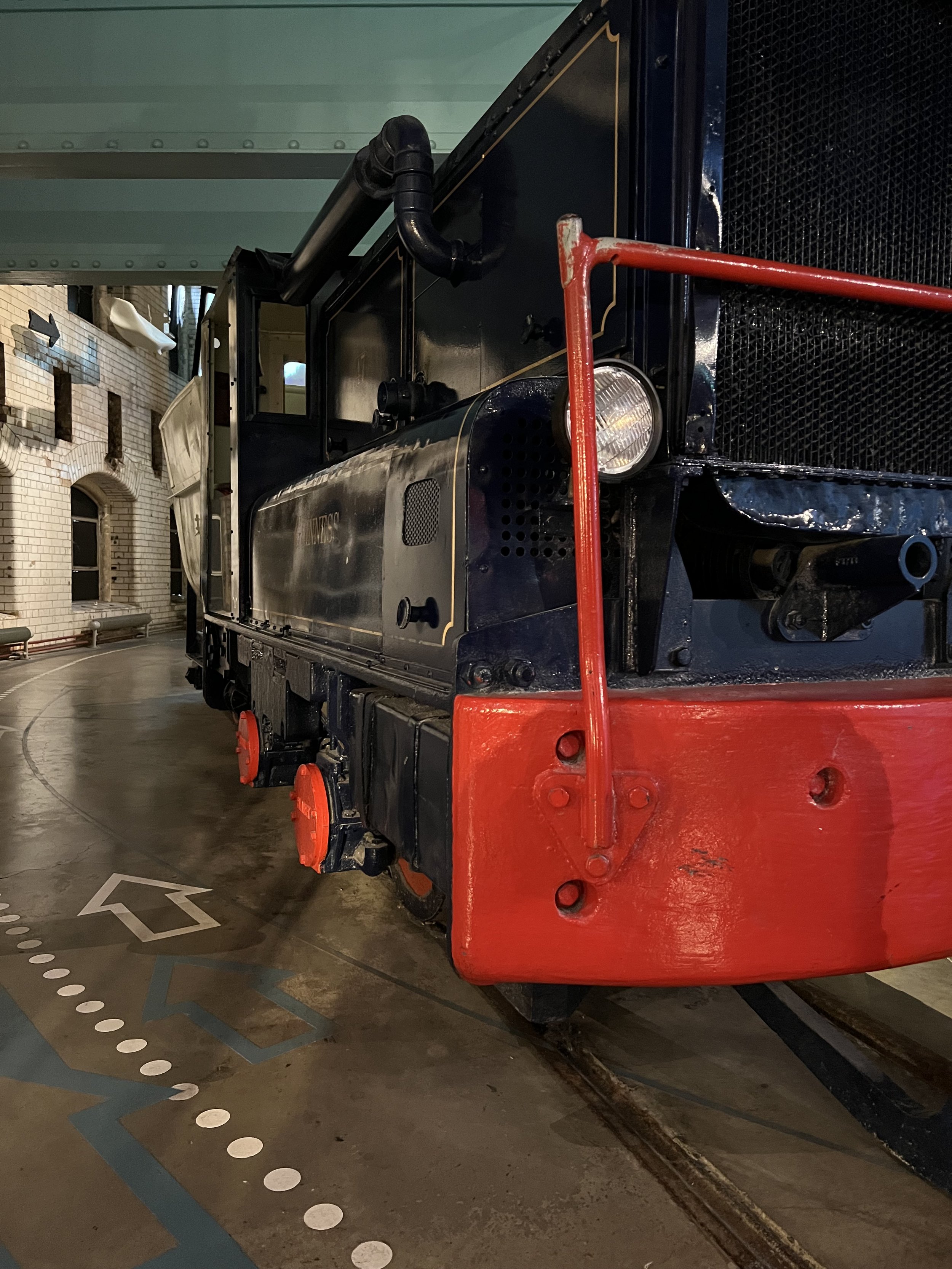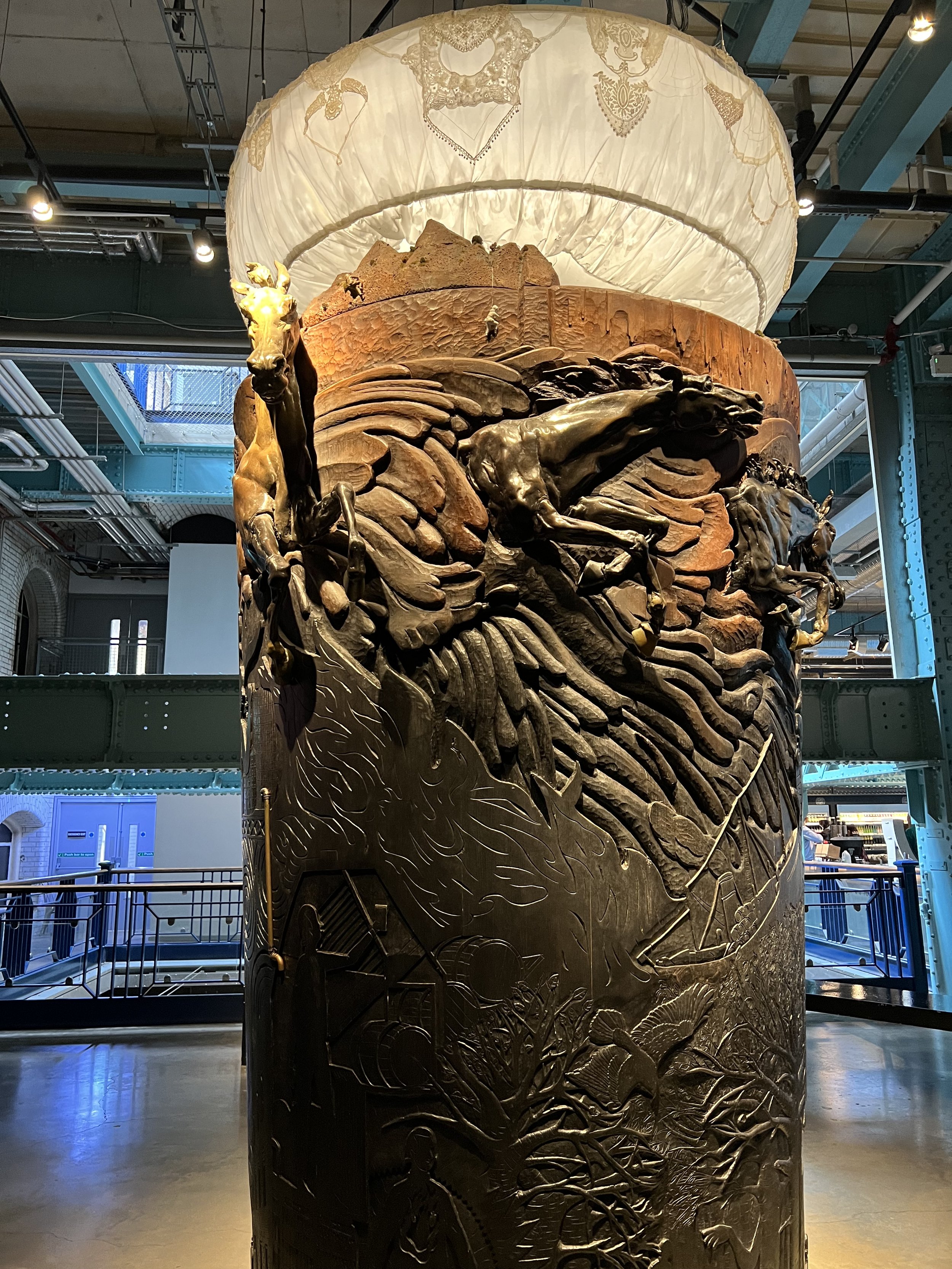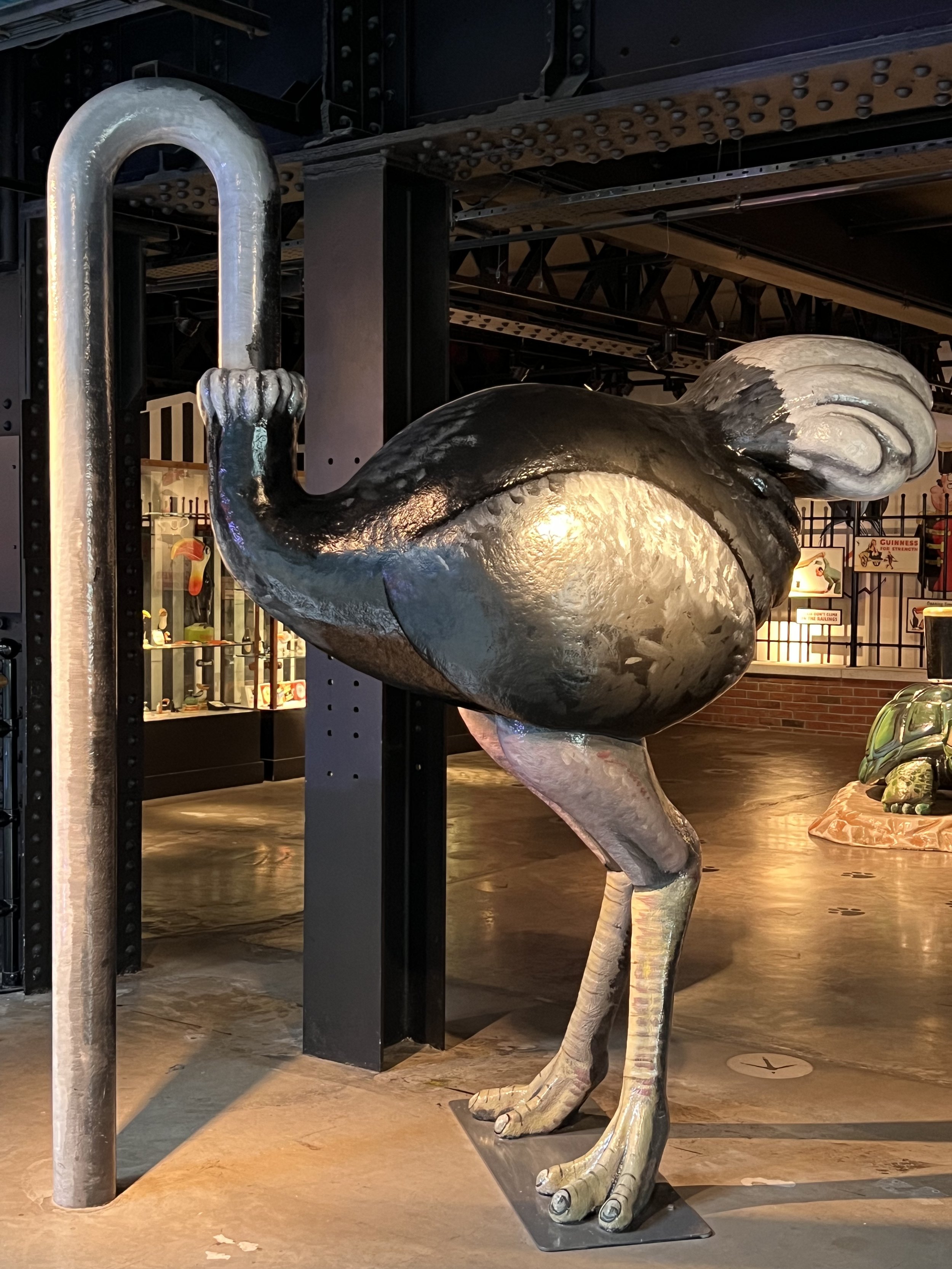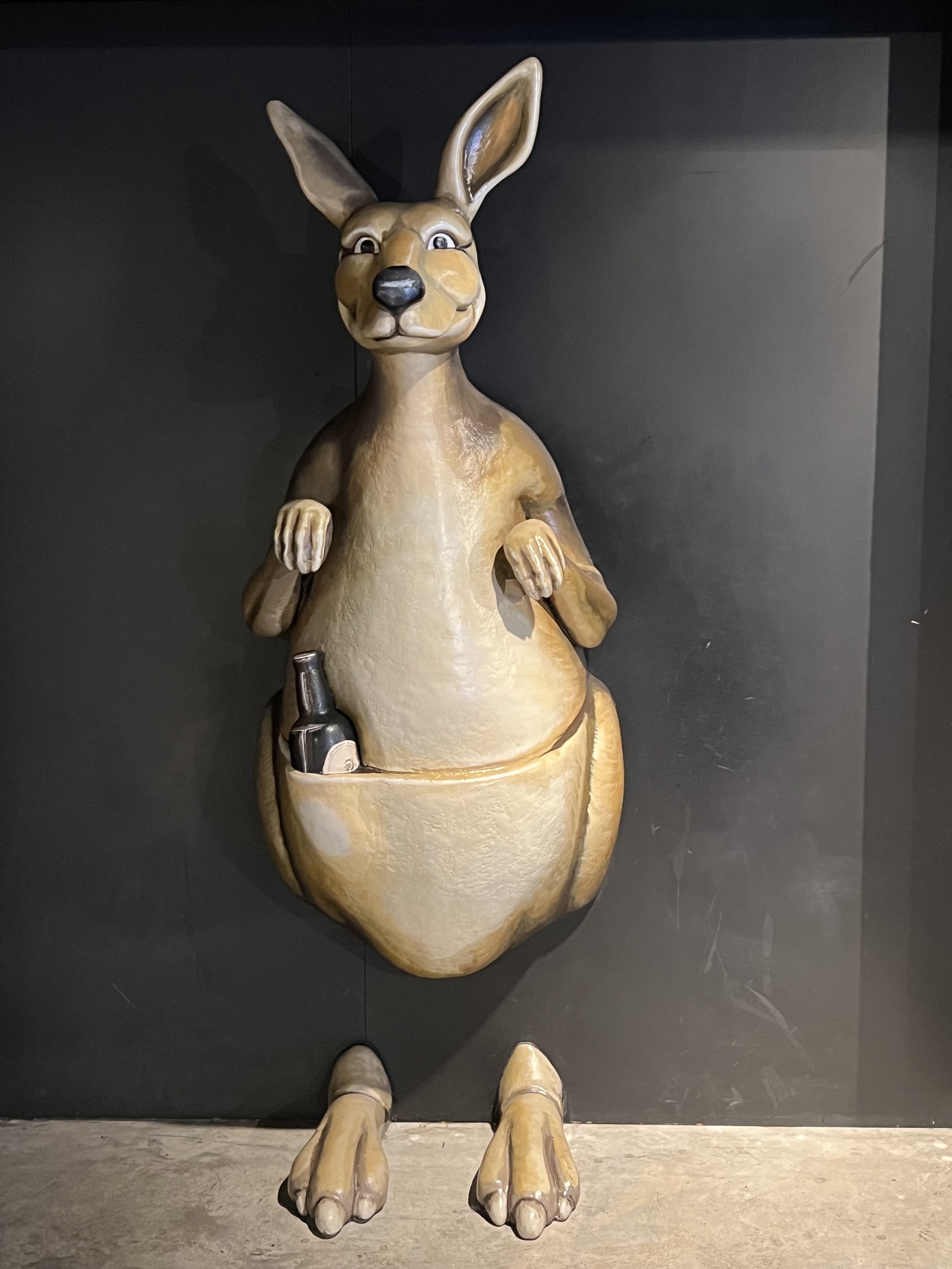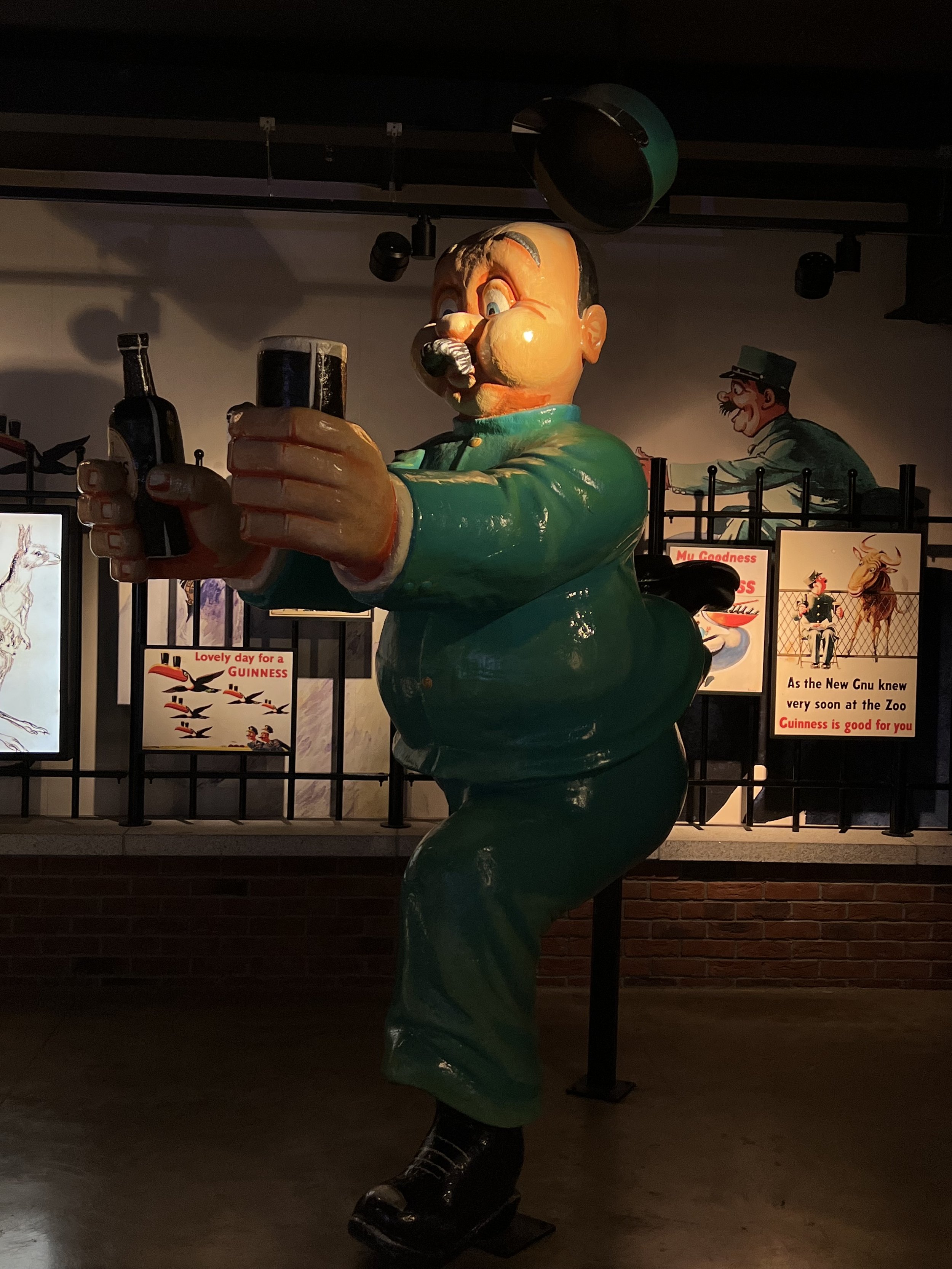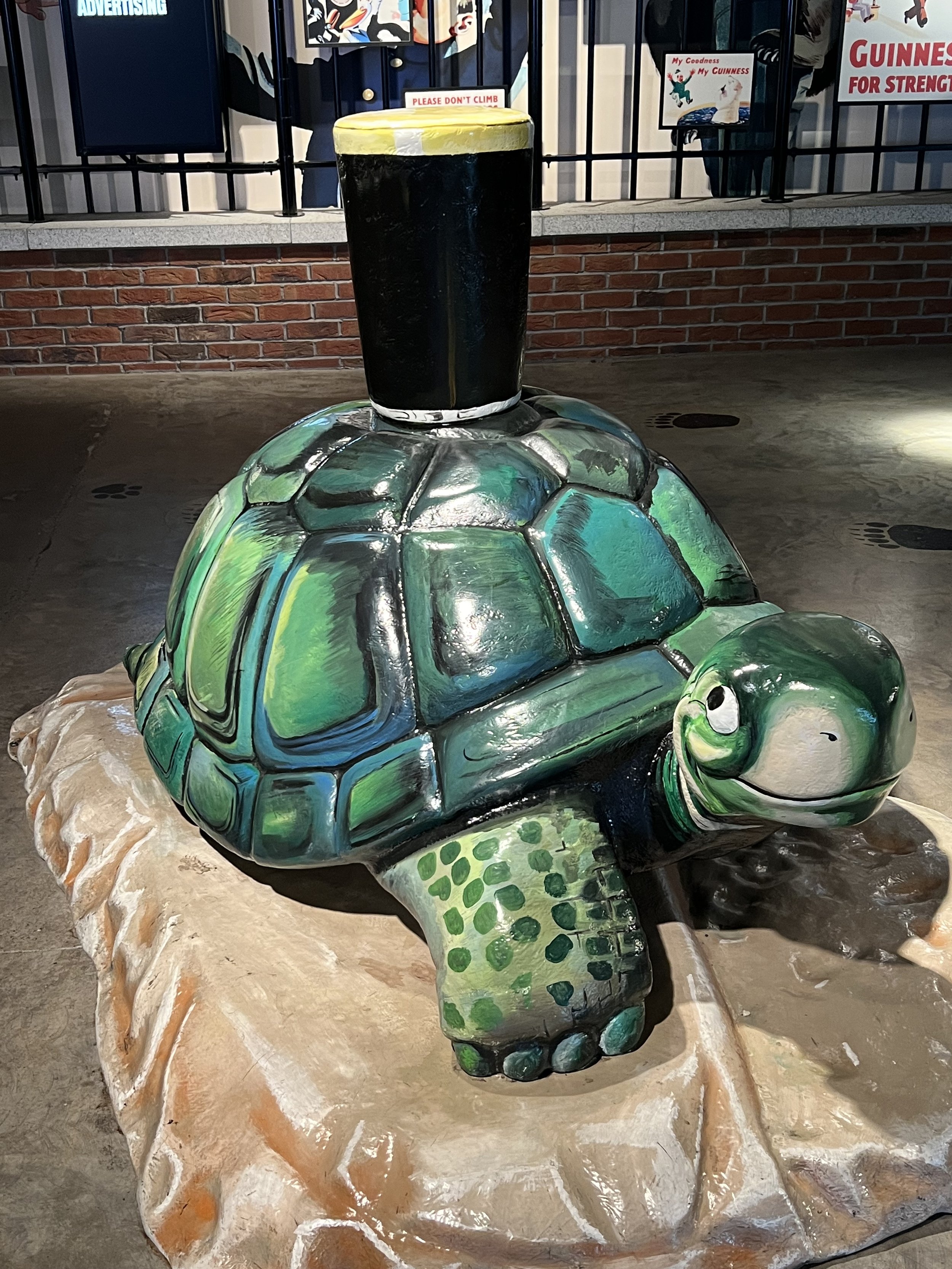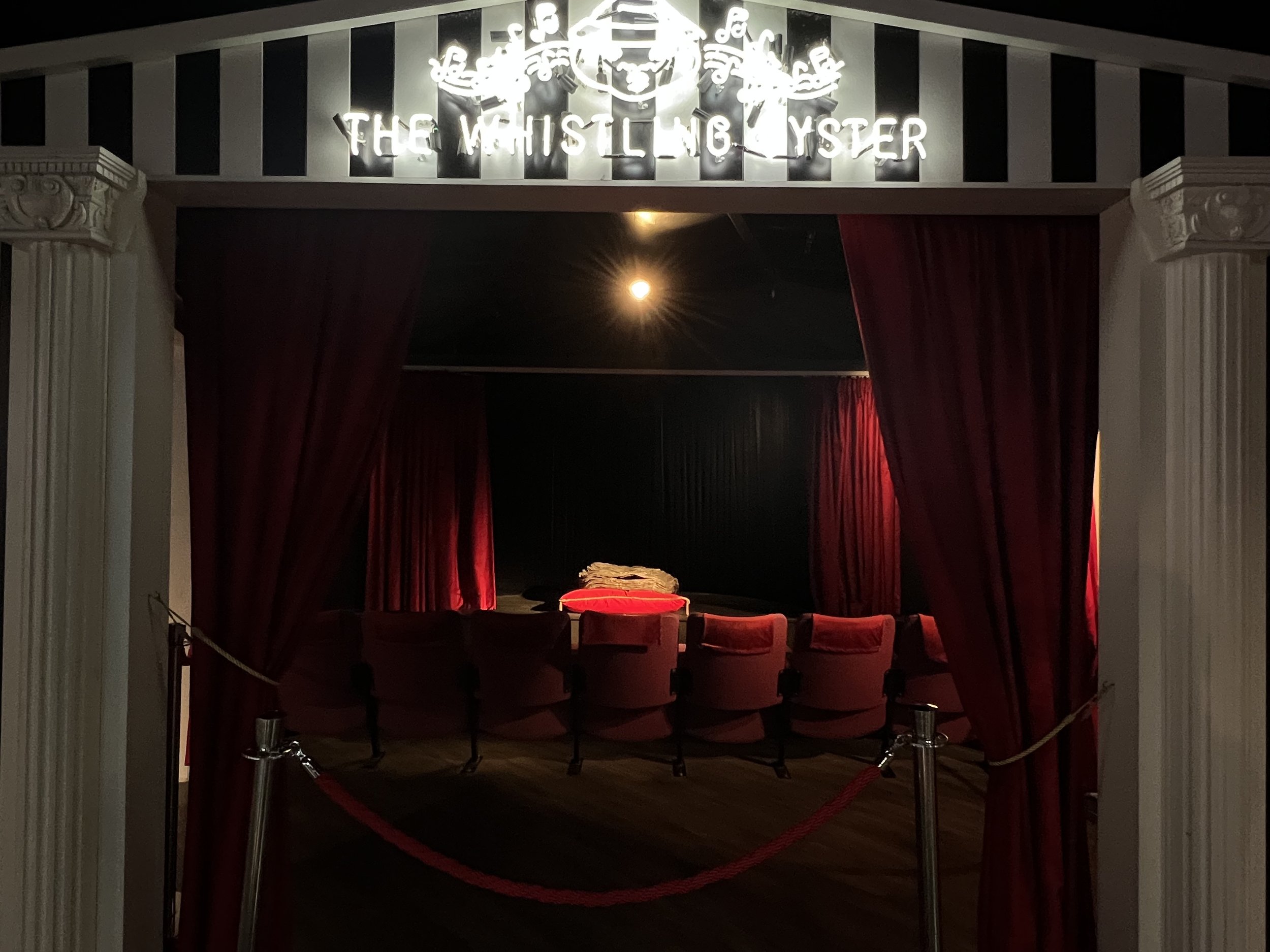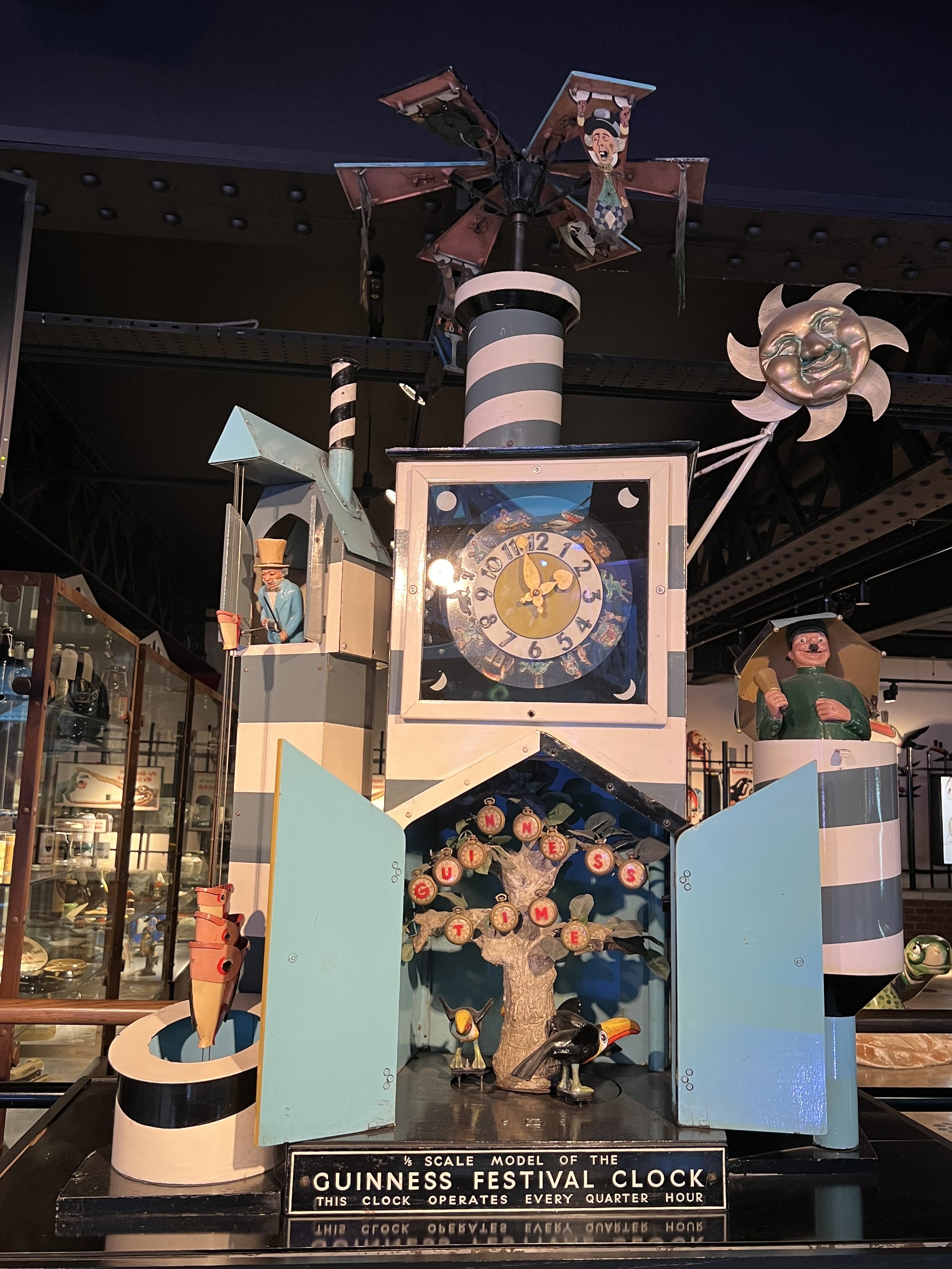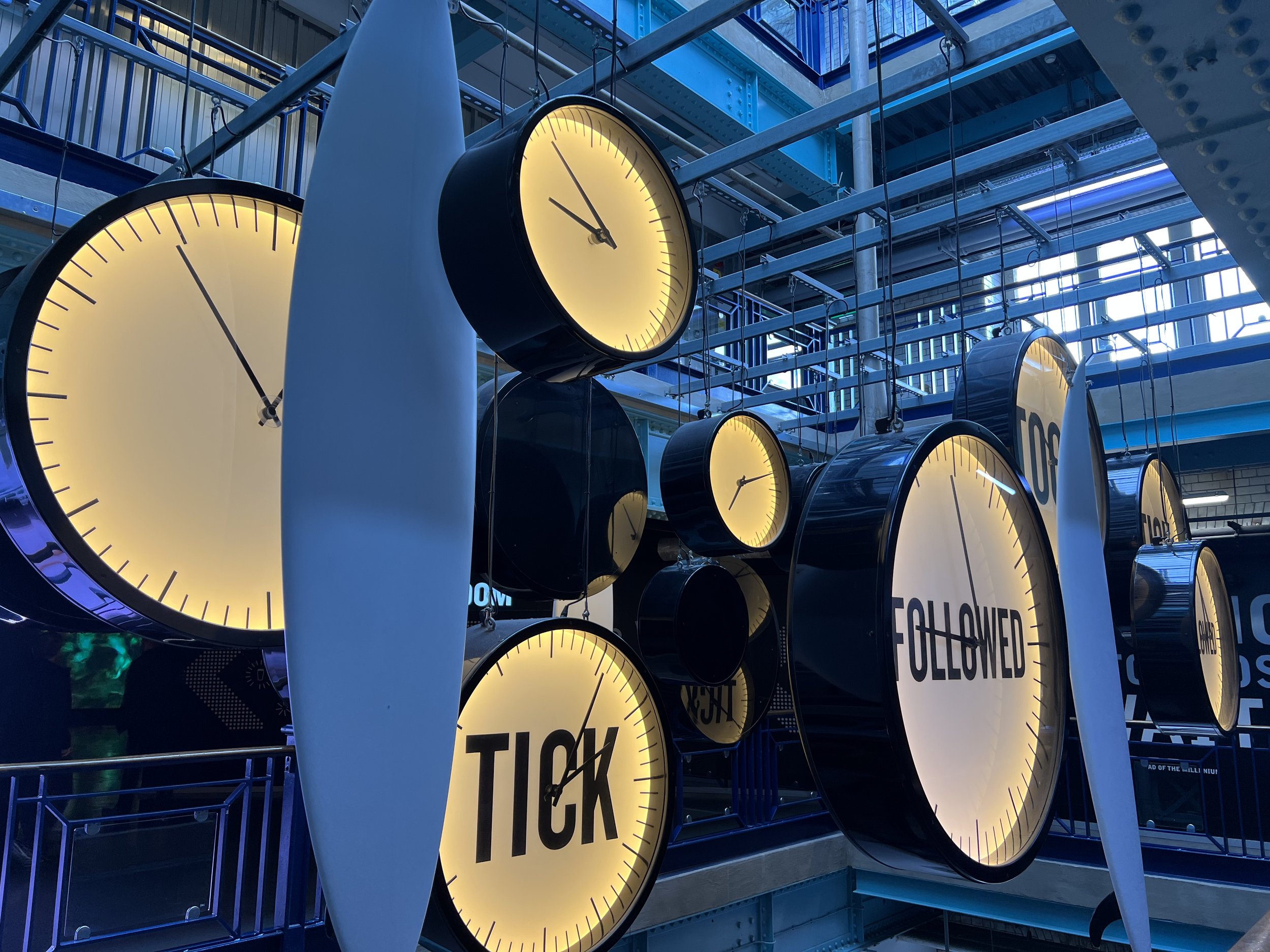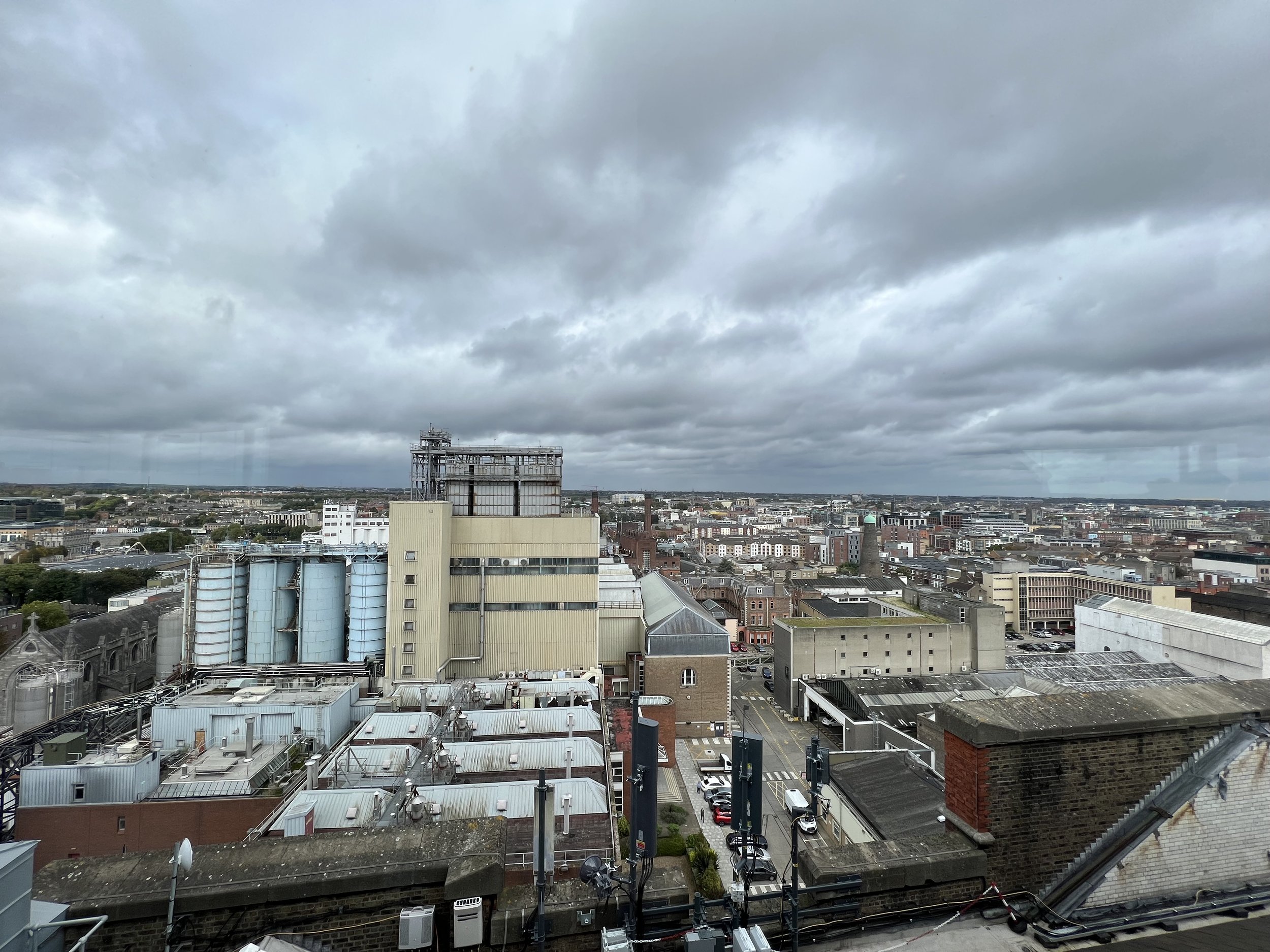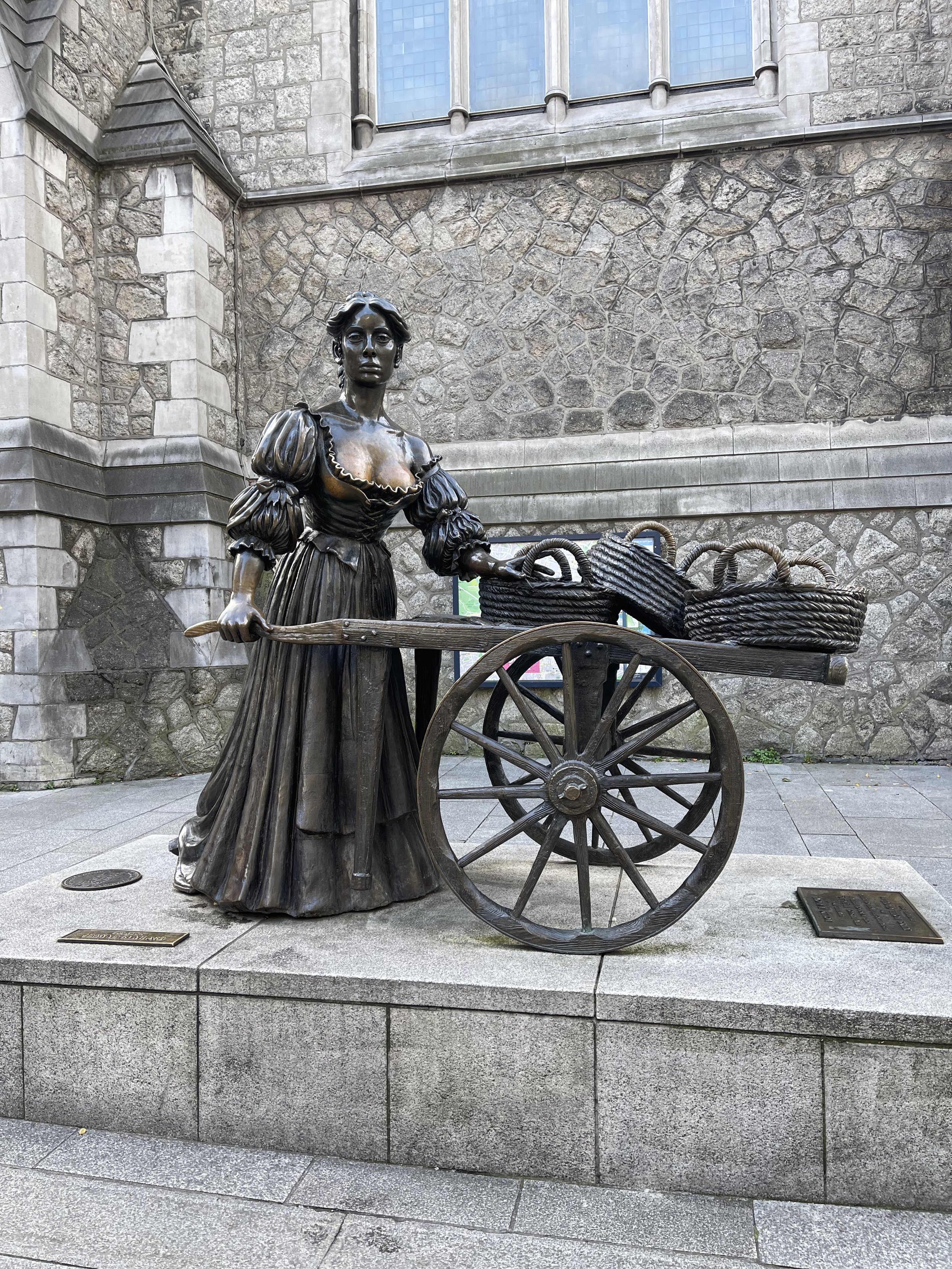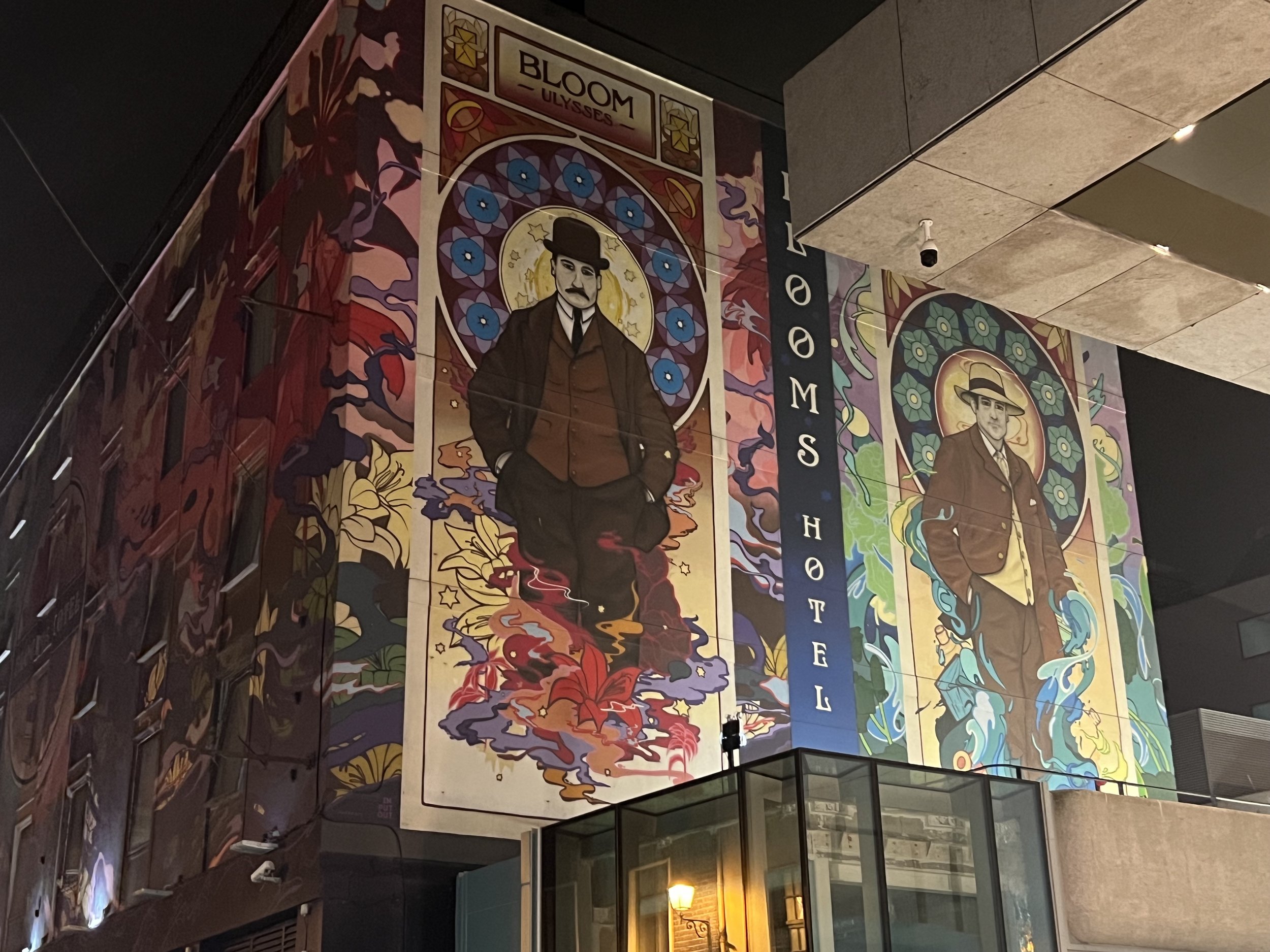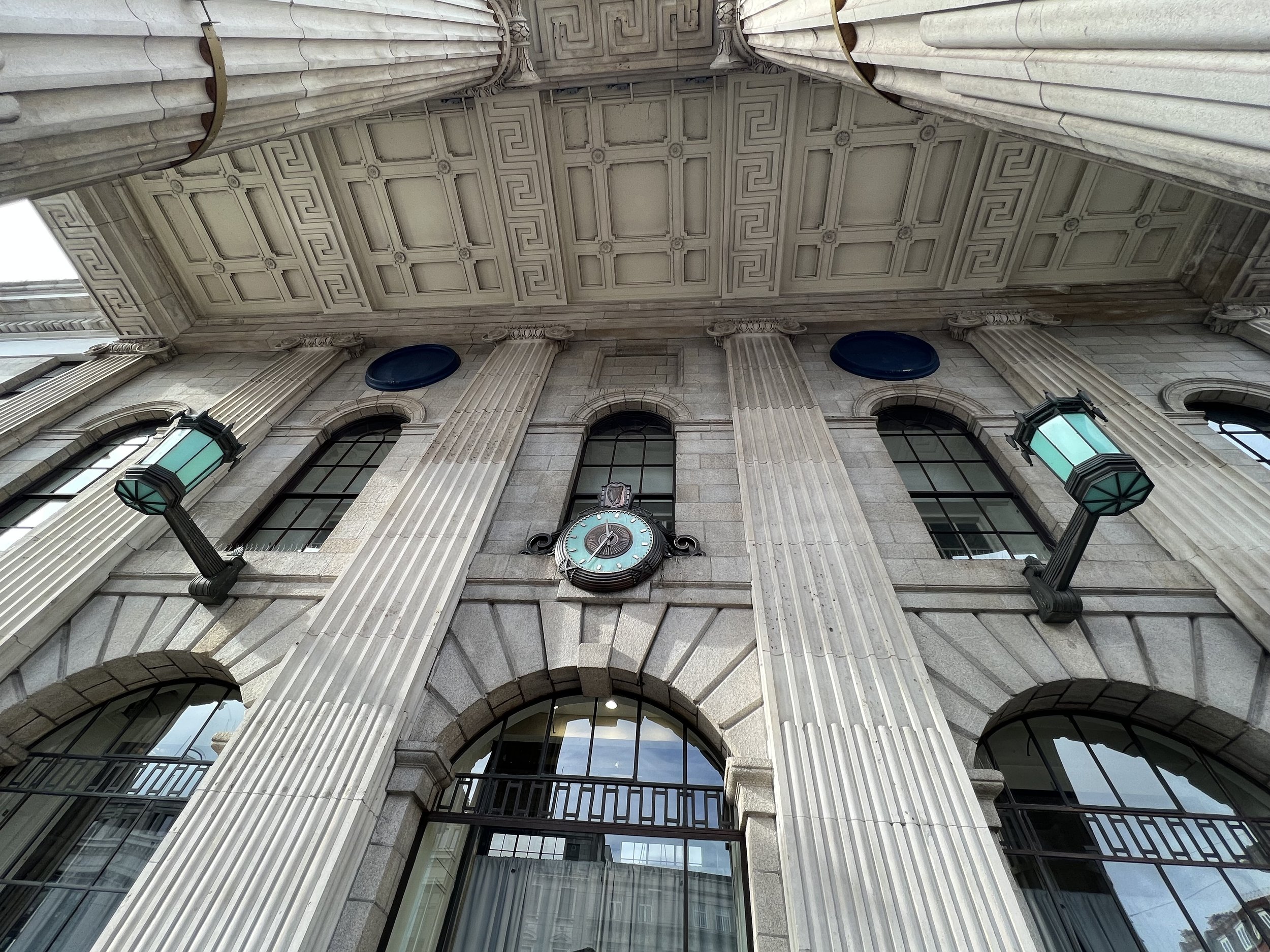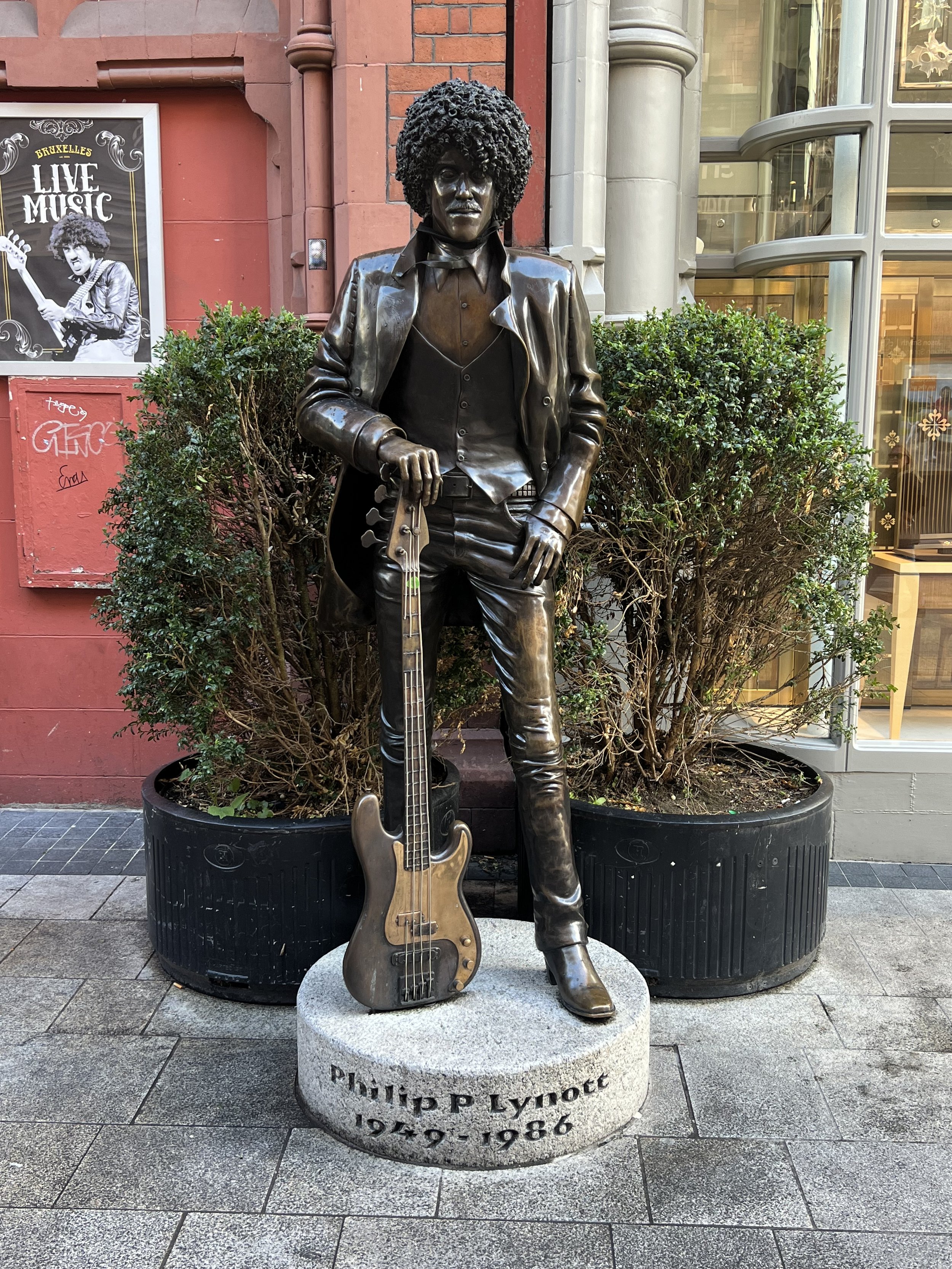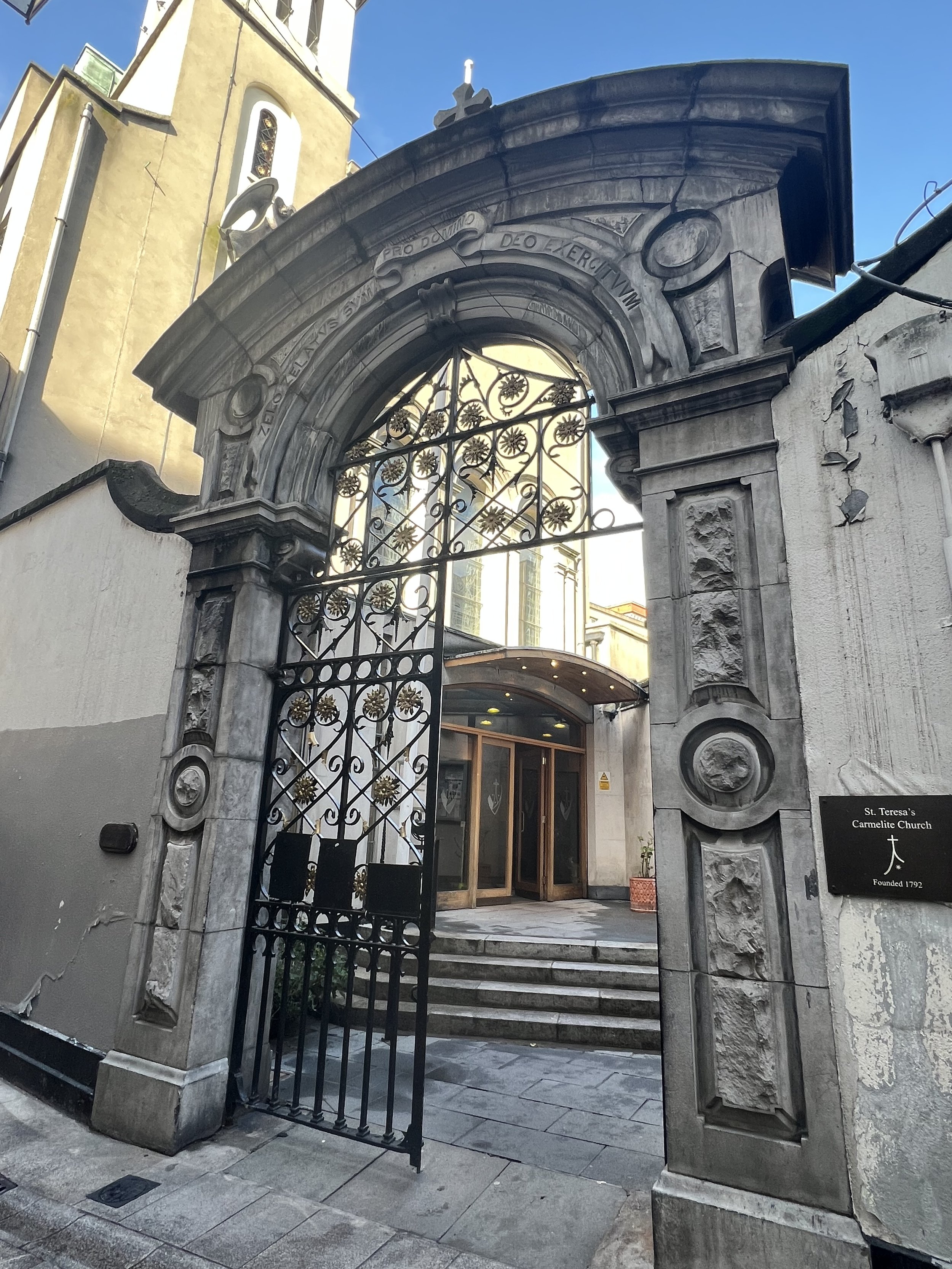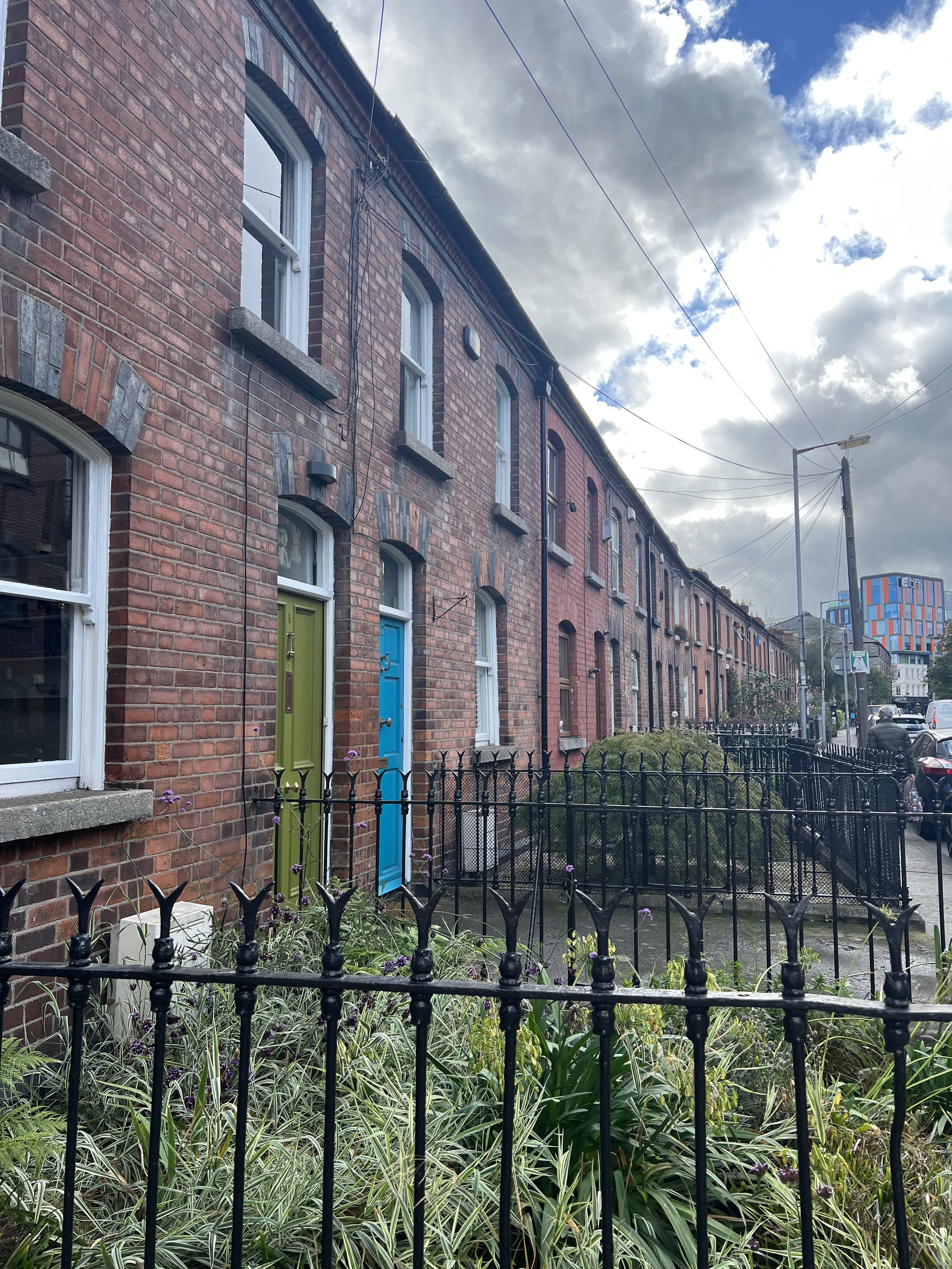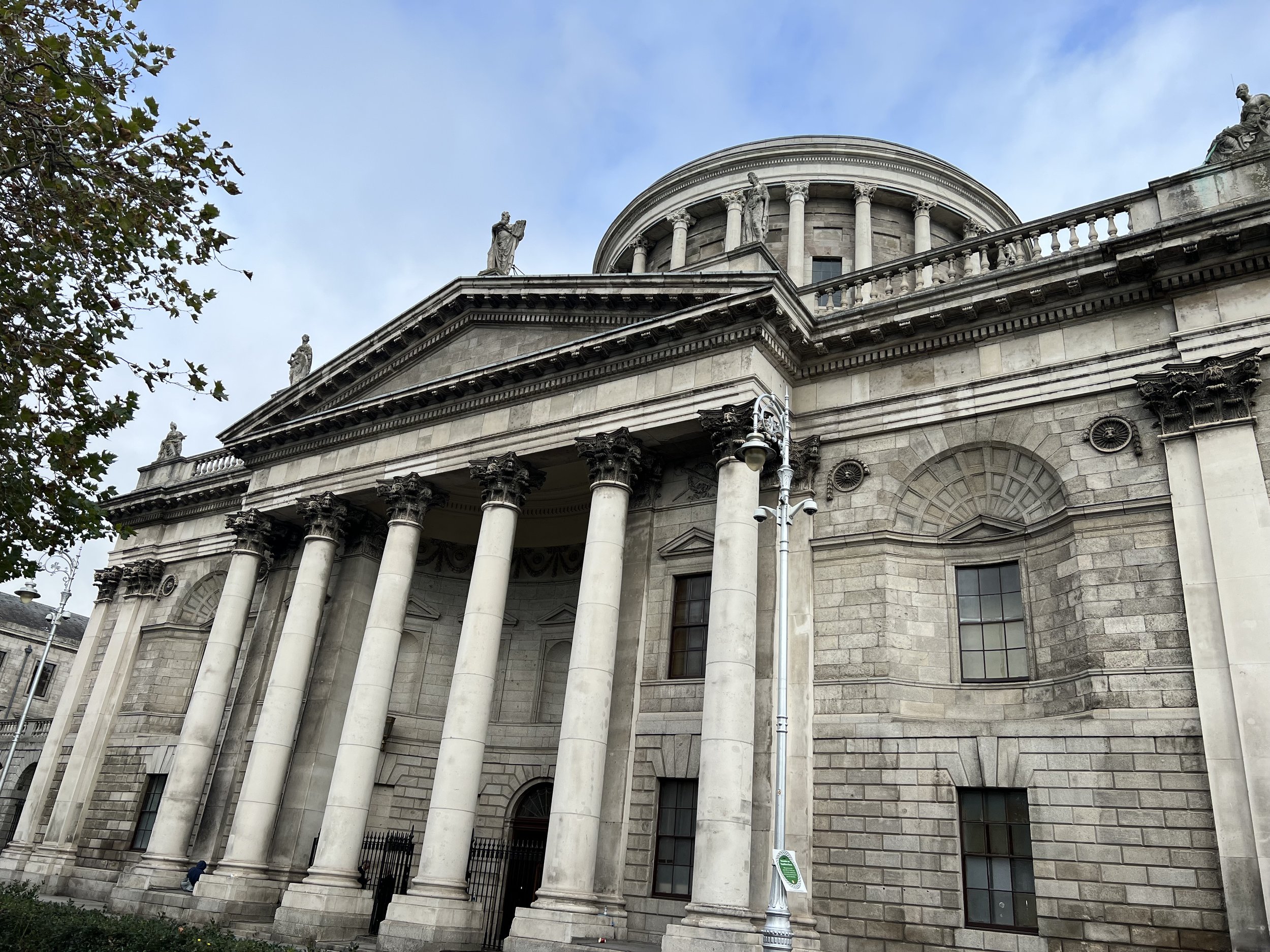Exploring Dublin, Ireland
Dublin views from the top of the Guinness Storehouse
Time needed in this city: 3 nights
Dublin has its own vibe as do the people that live and work there. It’s a frenetic, tense kind of energy that makes you realize just what the city is going through. With the student population taking over the city, a lot of migrants (some of which are dangerous), many tourists, not enough housing, and religious tension, you get the feeling it all could implode at any time. Was it worth the few days there? Absolutely. While there isn’t a lot of history left to see or a lot of true Irish people to interact with, being able to see the few wonders that have been kept just as they are, made it special, which means we recommend a few days there to experience it.
The below information is a complete guide of the best places to stay, the top rated places to dine and drink, and all there is to see and do. We’ve also included transportation tips, as well as a summary of the history of this busy city.
Jump To:
Where to Stay
The Clarence - AVOID IT
When I head that U2’s Bono owned the hotel, I imagined something very different than what we walked into… then I learned he sold it to a new management company in 2020, taking it from a “must-stay”, to a “must avoid”. Right along the River Liffey, it’s a fantastic location to get just about anywhere, but that’s about it. The rooms are showing wear, the walls are thin (we could hear every word to every song playing one floor below us until 1am), and the staff weren’t particularly helpful. They also do not serve and food - just overpriced snacks provided in your room. I advise you to strike this from your list of places to stay.
The Grafton
When we came back to Dublin, to fly out the next morning for home, we stayed at The Grafton, and I’m glad we did. The chicly-designed rooms were comfortable and spacious, while the staff’s service was impeccable. I definitely recommend a stay here.
Other recommendations
Where to Dine & Drink
Avoca Wool Shop & Cafe
While I did go in there to shop, I didn’t dine at the cafe. They serve breakfast and lunch, sourcing excellent Irish ingredients for great dishes and baked goods.
Chapter One
A two Michelin-starred restaurant, Chapter One is an elegant, fine-dining restaurant featuring elevated lunches, 4-course dinners, and a tasting menu.
Cloud Nine
A kitschy little gelato place that is a must-try!
Dax
Opened since 2004, Dax offers elegant dining and fine French cuisine in Dublin’s historic Georgian quarter.
Etto
A casual eatery focused on locally-sourced ingredients.
Grano
Grano combines fresh natural ingredients, farmed using organic and biodynamic techniques, to create a contemporary cuisine that respects the roots and traditions of Italian cooking.
Lemon Jelly Cafe
A great 70s-inspired diner with a fantastic breakfast menu (loads of gluten-free options), coffee drinks, and fresh juices,
Mister S
A Michelin-rated restaurant, their chefs use wood and charcoal burning techniques to cook their assortment of locally-sourced meat. While the wine was great, I wasn’t impressed with the food or the fact that you were required to order three courses and sides didn’t count.
Mr. Fox
Opened in 2016, this Michelin-rate restaurant serves contemporary Irish with a French influence.
Mulberry Garden
They are open 4 nights a week (every Wednesday to Saturday) from 6pm. They offer a 3 -course set menu based on seasonal, locally grown produce, for €75.
Restaurant Six
Their tasty A La Carte and Table D’Horte menus combine locally sourced produce with the creativity of their chefs. Their suppliers are carefully selected for their passion and consistent excellence.
Restorxed Cathedral at The Church
The Church is an incredibly restored 17th century former Church, steeped in history. Today, it welcomes patrons from all over the world to experience the very best of Irish Hospitality in one of the Worlds most unique settings.
Richmond
A Michelin restaurant that offers an array of contemporary cooking.
Sano Pizza
The minute we checked in at the hotel, we beelined for any place that was Celiac-friendly. Sano pizza not only delivered great gluten-free pizzas but a great wine list as well!
Taste Food Company
Ever find a good food spot and wish you had known about it sooner? This is how we felt about this cafe/restaurant! The service was impeccable, the French setting was intimate, and their gluten-free options for breakfast were outstanding!
Temple Bar Pub
Opened in 1840 (and still operating), it’s changed ownership a few times, but has remained authentically the same. They now even have their own brands of limited edition whiskey, which you can taste in their intimate tasting room directly to the left and behind the pub.
The Buckley
A popular steakhouse in the Temple Bar district.
The Little Kitchen
A casual atmosphere that serves locally-sourced Irish food.
Trocadero
For the last 65 years, Trocadero has been known as the “theatre restaurant”, serving celebrities of stage and screen. They focus on locally-sourced food, especially their cuts of meat.
Vintage Cocktail Club (speakeasy)
All I can say is I wish we hadn’t had dinner reservations because we could have spent another couple of hours here. Opened in 2012, the speakeasy is set over 3 floors, including a roof terrace, that has been transformed into the epitome of 1920s chic – vintage trinkets, antique furniture, a roaring fire and beautiful art bedecks their walls.
WILDE
Serves upscale, Irish fair in a 1930s garden setting.
Things to See & Do
Dublin at night
Day Trips
Day Trip to The Cliffs of Moher
Escape the hustle and bustle of Dublin in favor of the rugged coastal splendor of the Cliff’s of Moher and Galway City on an enriching full-day excursion from the Irish capital. From the comfort of a luxury coach, admire stunning Irish countryside and travel along the Wild Atlantic Way to the incredible 700-foot high Cliffs of Moher. Browse intriguing exhibitions in the visitor center; marvel at the lunar limestone landscape of Burren, renowned for its rare flowers; and absorb the cosmopolitan charm of Galway City during some leisurely free time.
Giant Causeway, Dark Hedges & Whiskey Distillery tour from Dublin
Get more out of your visit to the UNESCO-listed Giant's Causeway, and book a trip that also includes Titanic Distillery whiskey tasting and visits to Belfast and the Dark Hedges, too. You'll leave Dublin early with a professional guide, listening to commentary as you go, then spend ample time at each of the sites to take photos, sightsee, and sample Irish whiskey.
Northern Ireland Highlights Day Trip Including Giant's Causeway from Dublin
Explore Northern Ireland's biggest draws—Belfast, Giant’s Causeway, and Dunluce Castle—on a day trip from Dublin. In a traditional black cab in Belfast, you’ll explore sites of the capital’s conflicted history: the mural-strewn streets of the Falls and Skankill neighborhoods and the Belfast Docks. Then course along the Antrim Coast to experience one of Ireland great geological marvels, the UNESCO–listed Giant’s Causeway, followed by a stop at the Dunluce Castle, which was used as the filming location for House Greyjoy in "Game of Thrones."
Historical Exploration
Abandoned Prison of Kilmainham Gaol
When it was first built in 1796, Kilmainham Gaol was called the "New Gaol" to distinguish it from the old prison it was intended to replace – a noisome dungeon, just a few hundred meters from the present site. Originally, public hangings took place at the front of the prison. However, from the 1820s onward very few took place, though a small hanging cell was built in the prison in 1891. There was also no segregation of prisoners; men, women and children (the youngest was seven years old) were incarcerated in the same cell, up to 5 in each with only a single candle (that had to last for two weeks for light and heat. It was decommissioned as a prison by the Irish Free State government in 1924.
Book of Kells & Trinity College Library
A Brief History
Trinity College (officially The College of the Holy and Undivided Trinity of Queen Elizabeth) is the sole constituent college of the University of Dublin. Queen Elizabeth I founded the college in 1592 as "the mother of a university" that was modeled after the collegiate universities of Oxford and Cambridge, but unlike these affiliated institutions, only one college was ever established. It is one of the seven ancient universities of Britain and Ireland, as well as Ireland's oldest surviving university. The college's main campus, in the heart of Dublin, has often been ranked among the most iconic in the world, and is the setting for a number of novels, films and urban legends.
The Library of Trinity College is a legal deposit library for Ireland and Great Britain, containing around 7 million printed volumes and significant quantities of manuscripts, including the Book of Kells, which arrived at the college in 1661 for safekeeping after the Cromwellian raids on religious institutions. The collection housed in the Long Room includes a rare copy of the 1916 Proclamation of the Irish Republic and a 15th-century wooden harp, which is the model for the current emblem of Ireland. The library receives more than 500,000 visitors per year.
Our Experience
While there was timed entry, it was quite crowded, though absolutely spectacular. You start through a small museum about the Book of Kells, which takes you to a dimly-lit room to view the book (it was encased in glass and open to a page in it, which was a bit underwhelming). From there, you proceed to the old library (the long library) and again, while crowded, the smell from the old books and the centuries-old wood, coupled with the beautiful lighting from the windows, seems to distract you from that. It’s a must-do!
Dublin Castle
The castle dates back to 1204 (with much of the current buildings dating back from the 18th century) and was chosen for its position at the highest point of central Dublin. The Castle served as the seat of English, then later British, government of Ireland under the Lordship of Ireland (1171–1541), the Kingdom of Ireland (1541–1800), and the United Kingdom of Great Britain and Ireland (1800–1922). After the signing of the Anglo-Irish Treaty in December 1921, the complex was ceremonially handed over to the newly formed Provisional Government, led by Michael Collins. It now hosts the inauguration of each President of Ireland and various State receptions.
Glasnevin Cemetery Museum
Prior to the establishment of this cemetery, Irish Catholics had no cemeteries of their own in which to bury their dead and, as the repressive Penal Laws of the 18th century placed heavy restrictions on the public performance of Catholic services, it had become normal practice for Catholics to conduct a limited version of their own funeral services in Protestant churchyards or graveyards. This situation continued until an incident at a funeral, held at St. Kevin's Churchyard in 1823, provoked public outcry when a Protestant sexton reprimanded a Catholic priest for proceeding to perform a limited version of a funeral mass. The outcry prompted Daniel O'Connell, champion of Catholic rights, to launch a campaign and prepare a legal opinion proving that there was actually no law passed forbidding praying for a dead Catholic in a graveyard. O'Connell pushed for the opening of a burial ground in which both Irish Catholics and Protestants could give their dead dignified burial. Thus, Glasnevin Cemetery was consecrated and opened to the public for the first time on February 21, 1832. The first burial, that of eleven-year-old Michael Carey from Francis Street in Dublin, took place on the following day in a section of the cemetery known as Curran's Square. Besides the famous interred at Glasnevin, nearly 800,000 people have been buried in unmarked mass graves due to the death toll from the Great Famine of the 1840s and later, a cholera epidemic.
Guinness Storehouse
A Brief History
Arthur Guinness started brewing ales in 1759 at the St. James's Gate Brewery in Dublin. On December 31, 1759, he signed a 9,000 year lease at £45 per annum for the unused brewery. Ten years later, on May 19, 1769, Guinness first exported his ale - six-and-a-half barrels to Great Britain. Some interesting facts about the company:
In October 1886, Guinness became a public company and was averaging sales of 1.138 million barrels a year. They were valued at £6 million and shares were 20 times oversubscribed, with share prices rising to a 60 per cent premium on the first day of trading.
When WWI broke out in 1914, employees at Guinness St. James Brewery were encouraged to join the British forces. Over 800 employees served in the war. This was made possible due to a number of measures put in place by Guinness: soldiers' families were paid half wages, and jobs were guaranteed upon their return. Of the 800 employees who fought, 103 did not return.
Before 1939, if a Guinness brewer wished to marry a Catholic, his resignation was requested. According to Thomas Molloy, writing in the Irish Independent, "It had no qualms about selling drink to Catholics but it did everything it could to avoid employing them until the 1960s.
Guinness thought they brewed their last porter in 1973. In the 1970s, following declining sales, the decision was taken to make Guinness Extra Stout more "drinkable". The gravity was subsequently reduced, and the brand was re-launched in 1981.
In the 1980s, as the IRA's bombing campaign spread to London and the rest of Britain, Guinness considered scrapping the harp as its logo.
Our Experience
While I can’t drink beer (due to Celiac), it is worth the price of admission. Seven floors of the beer-making process and a museum of old ads, three restaurants, tasting classes, and a 360 rooftop bar (with one free pint) are all available. The best part - seeing the original 9,000 year lease encased in a thick layer of plexiglass, on the floor of the atrium.
Ha’Penny Bridge
Before the Ha'penny Bridge was built, there were seven ferries, operated by a William Walsh, across the Liffey. The ferries were in a bad condition and Walsh was informed that he had to either fix them or build a bridge. Walsh chose the latter option and was granted the right to extract a ha'penny toll from anyone crossing it, for 100 years, which started in 1818. Initially, the toll charge was based not on the cost of construction, but to match the charges levied by the ferries it replaced. A further condition of construction was that if the citizens of Dublin found the bridge and toll to be "objectionable", within its first year of operation, it was to be removed at no cost to the city.
The toll was increased for a time to a penny-ha'penny (1½ pence), but was eventually dropped in 1919. While the toll was in operation, there were turnstiles at either end of the bridge.
Old Jameson Distillery
The original distillery on this site was called the “Bow Street Distillery” and was established in 1780. John Jameson took full ownership and expanded the distillery in 1805. By 1810, the operation was officially renamed to John Jameson & Son’s Bow Street Distillery. The distillery grew to upwards of five acres in size by 1886. At this time, the distillery was described by many as a "city within a city", as it also housed a smithy, cooperage, saw mills, engineers, carpenters, painters, and coppersmiths’ shops. Following a difficult period that included American Prohibition, Ireland’s trade war with Great Britain, and the introduction of Scotch blended whiskey, the Jameson distillery fell on hard times and decided to form the Irish Distillers Group with their previous rivals, the Cork Distilleries Company and John Power & Son in 1966. Eventually, it became one of the last distilleries in Ireland to close in 1971.
NOTE: For a tour & tasting, click here.
The Brazen Head Pub - Ireland’s Oldest Pub
The Brazen Head is Ireland's oldest pub. In fact there has been a hostelry there since 1198 (though the present building was built in 1754 as a coaching inn). However The Brazen Head appears in documents as far back as 1653. It’s still open today and continues to provide the same look and feel throughout the centuries.
We stopped in for a quick dram of whiskey when it opened at 11am - make sure to get there when it opens for a quieter environment or after 6pm for a more lively feel.
Religious History
Christ Church Cathedral
The cathedral was founded in the early 11th century under the Viking king Sitric Silkenbeard. It was rebuilt in stone in the late 12th century under the Norman potentate Strongbow, and considerably enlarged in the early 13th century. A partial collapse in the 16th century left it in poor shape and the building was extensively renovated and rebuilt in the late 19th century, giving it the form it has today.
Oratory Of The Sacred Heart
Right outside of Dublin is a small chapel (oratory) that was built to celebrate the end of WWI, with a statue of the Sacred Heart, given to them from a town in Northern France where many of the local men had fought and died. Sister Concepta Lynch began painting the wall behind the statue after it was installed in 1919. People liked her mural so much they encouraged her to expand it. The nun spent 16 years transforming the oratory into the breathtaking masterpiece it is today.
St. Patrick’s Cathedral
A Brief History
St. Patrick’s Cathedral was built from 1220-1259 on an ancient well that it’s believed St. Patrick used himself. In 1270, the Lady Chapel (later to be known as the French Chapel because of its connection with the Huguenots) was added. In 1316, a violent storm blew down the spire of the building and in 1362, the Cathedral suffered substantial damage after an accidental fire. In 1370, repairs to the nave and the tower were carried out under the direction of Archbishop Minot, but then this structure also collapsed (1394) destroying much of the west end of the Cathedral in the process. Eventually the tower was rebuilt but was never renamed. This version still survives today. After the English Reformation Saint Patrick’s became an Anglican Cathedral and modifications were made to its interior to suit new theological changes, which ended up damaging much of it, demoting it to “church” status, and eventually assigned other uses, such as a court and classroom. In 1555, under Queen Mary, money was allocated for repair and restoration. In 1560, one of the first public clocks in Dublin was added to the tower and in 1700, a spire was added.
By the start of the 19th century, the Cathedral was once again in a dire state of disrepair. The north transept of the Cathedral (which was used as a separate chapel) was deemed unsafe for use. While it tried to raise funds, it was near impossible until Benjamin Lee Guinness wrote a letter to the board in 1860 offering to bear the total cost of the restoration. However, his sole stipulation was that he be not interfered with by the Cathedral board in this work. For the next five years, extensive restoration work took place, thanks to the 150,000 pounds he donated, The cathedral reopened in 1865.
Our Experience
Out of all the churches and cathedrals we had seen on our trip, this was, by far, the most stunning. You could spend hours looking at all of the statues, stained glass windows, paintings, plaques, chapels, etc. It is very much worth the visit.
The Arts & Sciences
Little Museum of Dublin
This museum reveals the history of a city that has undergone remarkable changes in the last 100 years, from the visit of Queen Victoria, to the global success of U2.
National Museum of Ireland
Collections for the museum started in 1792 , though Charles Giescke was the first to refer to the museum as the "National Museum of Ireland", in 1832. The museum operated in the buildings at Kildare Street and Merrion Square until the late 20th century projects were completed at Collins Barracks and County Mayo. As of 1975, the visitable collections were summarised as "Primary: Irish antiquities and history, fine arts (excluding painting and sculpture) and natural history (excluding botany), and additionally: Egyptian, Greek and Roman antiquities, Far Eastern art and ceramics, and ethnography and zoology," with an additional collection of folk life material not on display.
Oscar Wilde Statue
English sculptor Danny Osborne was commissioned by the Guinness Ireland Group to create a statue commemorating Oscar Wilde, which was unveiled in 1997, by Wilde's grandson Merlin Holland. It can be found in Merrion Square.
Unique Experiences
Hellfire Club
Built in 1725 as a hunting lodge, the Hellfire Club used stones from the cairn of a prehistoric passage grave on the summit. Shortly after completion, a storm blew the roof off. Local superstition attributed this incident to the work of the Devil - a punishment for interfering with the cairn. Members of the Irish Hell Fire Club, which was active in the years 1735 to 1741, used this lodge as a meeting place, with lore of wild behavior, debauchery, occult practices, and demonic manifestations often being told. When the lodge was damaged by fire, the members of the Hell Fire Club relocated down the hill to the nearby Stewards House (which also had a reputation for being haunted) for a brief period. The Hellfire Club is still known for numerous paranormal events today.
Hungry Tree At King’s Inns
Located on the grounds of the King’s Inn, In the early 1800s the tree had been planted and the bench installed, though no one realized that as the tree grew, it would encompass the bench.
Irish Food Trail
Enjoy an authentic taste of traditional Irish cuisine on this tasting tour of Dublin. Get the inside scoop on the city’s culinary scene as you seek out little-known local haunts on a walking tour. This small-group tour is limited for a personalized experience and stops at various locations, where you tuck into typical Irish dishes, accompanied by craft beers.
St. Michan’s Church Mummies
We attempted to see this, but it was closed (make sure to check the website on viewing days/times). St. Michan Church has an interesting history even without the mummies. The foundation of the church was built in 1095 to serve the ostracized Vikings, who were still in Ireland after the rest had been killed or kicked out by Wolf the Quarrelsome and other Irish forces in 1014. The church was rebuilt in 1686, and a large pipe organ was installed in 1724, on which Handel is said to have first played the Messiah. But all along, as the church changed, the crypt stayed the same: slowly mummifying all that lay within it. Down a set of dimly lit, narrow stone steps, in a vault underneath the church, lay dozens of coffins, with some mummies exposed.
Teeling Distillery
A Brief History
In 1782, Walter Teeling established a distillery on Dublin's Marrowbone Lane, in the Liberties area of Dublin, then an epicentre of distilling dubbed the "golden triangle" due to the number of distilleries located in the area. Although now long gone, some of the distilleries in the Liberties area, at the time, were very large operations, with George Roe's Thomas Street Distillery being the largest distillery in the world at its peak.
Eventually, the Teeling Distillery was purchased by a larger neighbouring operation, William Jameson & Co. However, that parent distillery, run by relatives of the more famous John Jameson, later closed in 1923, due to financial difficulty.
In 1987, John Teeling, a descendant of Walter Teeling, purchased a facility in Cooley, County Louth which had previously been set up by the Irish Free State Government to produce industrial alcohol from potatoes. Teeling converted this plant to a whiskey distillery, reopening it in 1989 as Cooley Distillery. The distillery was the first new distillery to launch in Ireland following the consolidations and closures of the 20th century.
John Teeling's two sons, Jack and Stephen, worked with their father at Cooley Distillery when it was sold to Beam Suntory in 2011. Jack, then managing director, left, while his brother stayed on for about a year.
As part of the sale, the Teelings negotiated the purchase of 16,000 casks of aged whiskey. Using these stocks, Jack Teeling launched Teeling Whiskey in 2012, and was later joined in the venture by his brother Stephen.
In 2015, the Teelings established a new whiskey distillery in Newmarket Square in Dublin's south inner city, not far from the location of the original Teeling Distillery on Marrowbone Lane.
The distillery, which includes a visitor centre, café and shop, now employs some 55 staff, and exports to 44 countries.
Our Experience
Blackbeard and I are both HUGE fans of whisky/whiskey, so it was a great surprise to not just visit the Teeling tasting room, but also see, smell, and hear the actual distillery process. We learned:
The three massive copper post stills each cost $1 million to hand make in Italy.
The three barrels in the vault - one belongs to each daughter and are the first three barrels made.
The more times you distill a whiskey, the clearer it gets with the clearest being called Poitín (think of grain alcohol but it’s actually whiskey).
After the tour, we had a tasting of three of their whiskeys, all three of which, came in various-sized bottles to purchase, including airplane-sized bottles. We also each had a cocktail and a Poitín (I actually enjoyed it), then headed over to the store to pick up some mini bottles and some locally-sourced Irish snacks. We highly recommend this tour!
Walking Tours
Of course, just by wandering the city you can find all sorts of street art, architecture, statues, and more. Check out some of our finds in the below gallery.
Dublin Highlights and Hidden Gems Guided Walking Tour
They will show you some of the absolute ‘must sees’ in Dublin, like Dublin Castle, Christchurch Cathedral and Trinity College, and also some of the city’s forgotten corners and hidden gems; always from our own unique perspective, with an insight and knowledge they feel they are uniquely placed to give you.
National Botanic Gardens
Poet Thomas Tickell owned a house and small estate in Glasnevin and, in 1795, were sold to the Irish Parliament, then given to the Royal Dublin Society to establish Ireland's first botanic gardens. A double line of yew trees, known as "Addison's Walk" survives from this period. Walter Wade and John Underwood, the first Director and Superintendent respectively, executed the layout of the gardens, but when Wade died in 1825, they declined for some years. In 1834, Director Ninian Nivan brought new life into the gardens with a redesign, which required ongoing work until the 1960s. Today, it’s the second most visited (free) attraction in Dublin.
How to Get Around
Taxis & rideshares
All are available and easy to get, though the taxis are a bit more expensive.
Train
The train system in Ireland is fantastic. We took a 2 1/2 hour train ride to Belfast and the first-class seats were incredibly comfortable and the staff, super friendly.
Airport (heading back into the U.S.)
Given how many daily flights go back and forth between Boston (alone), the Dublin airport works a bit more efficiently! You will go through security once when you arrive at the airport (after check-in) and then again when you get to the U.S. customs pre-security. This allows you to bypass immigration in the U.S.!
A History Summary
6000 years ago - The area of Dublin Bay has been inhabited by humans since prehistoric times - fish traps discovered from excavations, during the construction of the Convention Centre Dublin, indicate human habitation while further traps were also discovered closer to the old settlement of the city of Dublin, on the south quays, near St. James's Gate, which also indicate mesolithic human activity.
841 - The Vikings established a fortified base in Dublin.
Mid-to-late 10th century - The town grew into a substantial commercial center under Olaf Guthfrithson in and despite a number of attacks by the native Irish, it remained largely under Viking control.
1166 - It was upon the death of Muirchertach Mac Lochlainn in early 1166 that Ruaidrí Ua Conchobair, King of Connacht, proceeded to Dublin and was inaugurated King of Ireland without opposition.
1169 - Norman invasion of Ireland was launched from Wales
1171 - The King of Leinster, Diarmait Mac Murchada, after his exile by Ruaidhrí, enlisted the help of Strongbow, the Earl of Pembroke, to conquer Dublin. Following MacMurrough's death, Strongbow declared himself King of Leinster after gaining control of the city. In response to Strongbow's successful invasion, King Henry II of England affirmed his ultimate sovereignty by mounting a larger invasion and pronounced himself Lord of Ireland. Around this time, the county of the City of Dublin was established along with certain liberties adjacent to the city proper.
1204 - Dublin Castle, which became the centre of Anglo-Norman power in Ireland, was founded as a major defensive work on the orders of King John of England.
1229 - The appointment of the first Lord Mayor of Dublin was made.
End of 13th century - Dubling had a population of 8,000.
1348 - The Black Death took hold in Dublin and killed thousands over the following decade.
1592 - Queen Elizabeth I of England established Trinity College to make Dublin a Protestant City. She ordered that the Catholic St. Patrick's and Christ Church cathedrals be converted to the Protestant church.
1640 - The city had a population of 21,000.
1649 - 1651 - The plague wiped out almost half of the inhabitants.
18th century - The construction of many new districts and buildings happened, such as Merrion Square, Parliament House, and the Royal Exchange.
1700 - The city prospered soon after the plague as a result of the wool and linen trade with England, and reached a population of over 50,000 (the wool industry employed over 12,000 people alone).
1759 - The Guinness brewery was founded and would eventually grow to become the largest brewery in the world and the largest employer in Dublin.
1840 - The barony of Dublin City was separated from the barony of Dublin.
1916 - The Easter Rising (the Irish War of Independence) and the subsequent Irish Civil War resulted in a significant amount of physical destruction in central Dublin. The Government of the Irish Free State rebuilt the city centre and located the new parliament, the Oireachtas, in Leinster House.
1922 - The partition of Ireland made Dublin the capital of the Irish Free State (1922–1937) and now is the capital of Ireland.
1997 - The landscape of Dublin has changed. The city was at the forefront of Ireland's economic expansion during the Celtic Tiger period, with private sector and state development of housing, transport and business. Following an economic decline during the Great Recession,
2017 - today - Dublin has close to full employment, but has a significant problem with housing supply in both the city and surrounding areas, which is still the case today.


